Port Reading, NJ Map & Demographics
Port Reading Map
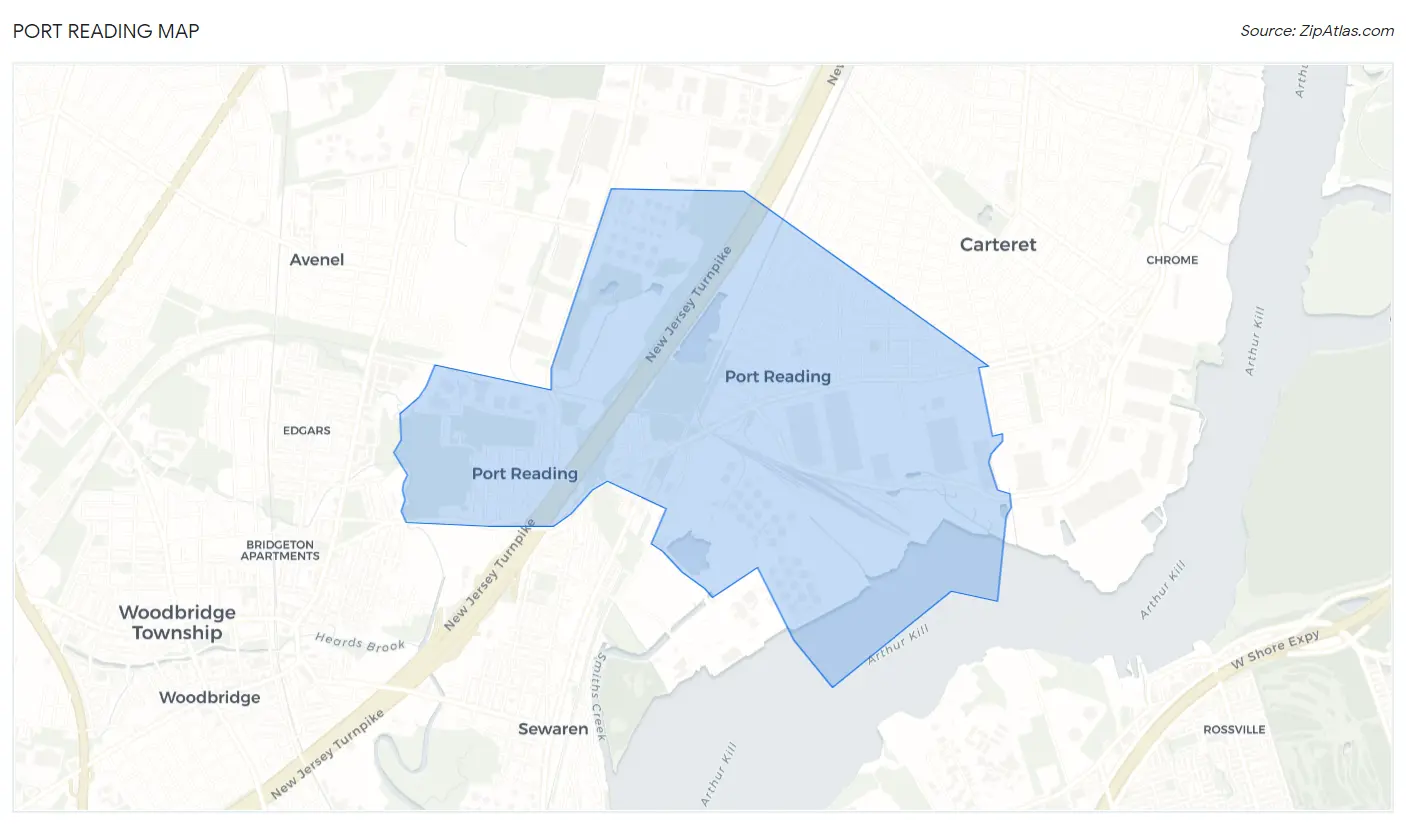
Port Reading Overview
$42,821
PER CAPITA INCOME
$143,977
AVG FAMILY INCOME
$139,864
AVG HOUSEHOLD INCOME
12.2%
WAGE / INCOME GAP [ % ]
87.8¢/ $1
WAGE / INCOME GAP [ $ ]
0.28
INEQUALITY / GINI INDEX
4,040
TOTAL POPULATION
2,109
MALE POPULATION
1,931
FEMALE POPULATION
109.22
MALES / 100 FEMALES
91.56
FEMALES / 100 MALES
40.6
MEDIAN AGE
3.7
AVG FAMILY SIZE
3.3
AVG HOUSEHOLD SIZE
2,377
LABOR FORCE [ PEOPLE ]
74.2%
PERCENT IN LABOR FORCE
5.5%
UNEMPLOYMENT RATE
Port Reading Zip Codes
Income in Port Reading
Income Overview in Port Reading
Per Capita Income in Port Reading is $42,821, while median incomes of families and households are $143,977 and $139,864 respectively.
| Characteristic | Number | Measure |
| Per Capita Income | 4,040 | $42,821 |
| Median Family Income | 1,006 | $143,977 |
| Mean Family Income | 1,006 | $148,088 |
| Median Household Income | 1,219 | $139,864 |
| Mean Household Income | 1,219 | $135,624 |
| Income Deficit | 1,006 | $0 |
| Wage / Income Gap (%) | 4,040 | 12.18% |
| Wage / Income Gap ($) | 4,040 | 87.82¢ per $1 |
| Gini / Inequality Index | 4,040 | 0.28 |
Earnings by Sex in Port Reading
Average Earnings in Port Reading are $57,342, $63,286 for men and $55,577 for women, a difference of 12.2%.

| Sex | Number | Average Earnings |
| Male | 1,268 (54.8%) | $63,286 |
| Female | 1,044 (45.2%) | $55,577 |
| Total | 2,312 (100.0%) | $57,342 |
Earnings by Sex by Income Bracket in Port Reading
The most common earnings brackets in Port Reading are $100,000+ for men (375 | 29.6%) and $75,000 to $99,999 for women (202 | 19.4%).
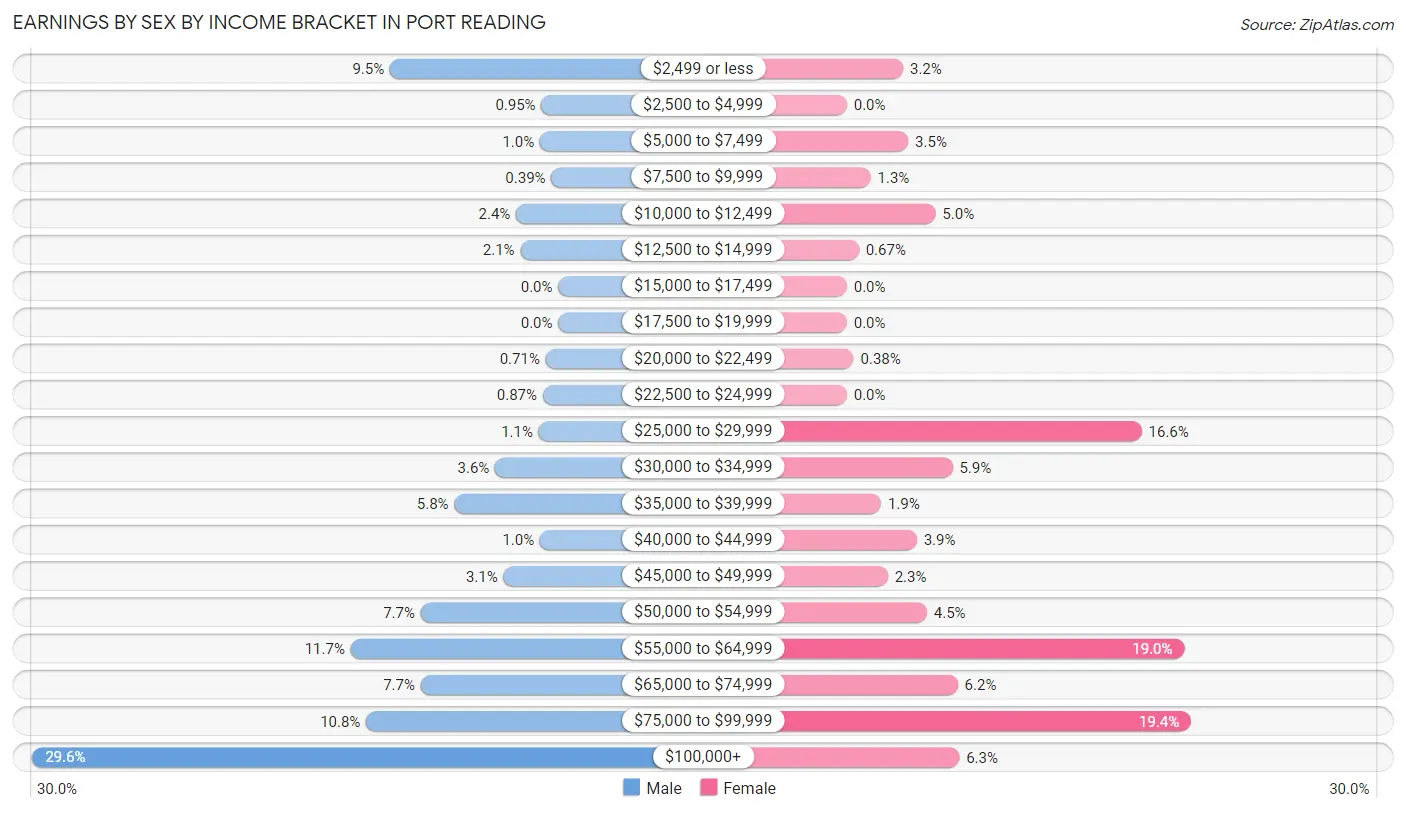
| Income | Male | Female |
| $2,499 or less | 120 (9.5%) | 33 (3.2%) |
| $2,500 to $4,999 | 12 (0.9%) | 0 (0.0%) |
| $5,000 to $7,499 | 13 (1.0%) | 36 (3.5%) |
| $7,500 to $9,999 | 5 (0.4%) | 14 (1.3%) |
| $10,000 to $12,499 | 30 (2.4%) | 52 (5.0%) |
| $12,500 to $14,999 | 27 (2.1%) | 7 (0.7%) |
| $15,000 to $17,499 | 0 (0.0%) | 0 (0.0%) |
| $17,500 to $19,999 | 0 (0.0%) | 0 (0.0%) |
| $20,000 to $22,499 | 9 (0.7%) | 4 (0.4%) |
| $22,500 to $24,999 | 11 (0.9%) | 0 (0.0%) |
| $25,000 to $29,999 | 14 (1.1%) | 173 (16.6%) |
| $30,000 to $34,999 | 45 (3.5%) | 62 (5.9%) |
| $35,000 to $39,999 | 74 (5.8%) | 20 (1.9%) |
| $40,000 to $44,999 | 13 (1.0%) | 41 (3.9%) |
| $45,000 to $49,999 | 39 (3.1%) | 24 (2.3%) |
| $50,000 to $54,999 | 98 (7.7%) | 47 (4.5%) |
| $55,000 to $64,999 | 148 (11.7%) | 198 (19.0%) |
| $65,000 to $74,999 | 98 (7.7%) | 65 (6.2%) |
| $75,000 to $99,999 | 137 (10.8%) | 202 (19.4%) |
| $100,000+ | 375 (29.6%) | 66 (6.3%) |
| Total | 1,268 (100.0%) | 1,044 (100.0%) |
Earnings by Sex by Educational Attainment in Port Reading
Average earnings in Port Reading are $65,559 for men and $58,095 for women, a difference of 11.4%. Men with an educational attainment of bachelor's degree enjoy the highest average annual earnings of $108,693, while those with less than high school education earn the least with $37,045. Women with an educational attainment of bachelor's degree earn the most with the average annual earnings of $78,460, while those with high school diploma education have the smallest earnings of $36,750.

| Educational Attainment | Male Income | Female Income |
| Less than High School | $37,045 | $0 |
| High School Diploma | $37,165 | $36,750 |
| College or Associate's Degree | $65,987 | $58,000 |
| Bachelor's Degree | $108,693 | $78,460 |
| Graduate Degree | $108,214 | $61,932 |
| Total | $65,559 | $58,095 |
Family Income in Port Reading
Family Income Brackets in Port Reading
According to the Port Reading family income data, there are 362 families falling into the $100,000 to $149,999 income range, which is the most common income bracket and makes up 36.0% of all families.

| Income Bracket | # Families | % Families |
| Less than $10,000 | 0 | 0.0% |
| $10,000 to $14,999 | 0 | 0.0% |
| $15,000 to $24,999 | 0 | 0.0% |
| $25,000 to $34,999 | 6 | 0.6% |
| $35,000 to $49,999 | 62 | 6.2% |
| $50,000 to $74,999 | 97 | 9.6% |
| $75,000 to $99,999 | 85 | 8.4% |
| $100,000 to $149,999 | 362 | 36.0% |
| $150,000 to $199,999 | 219 | 21.8% |
| $200,000+ | 175 | 17.4% |
Family Income by Famaliy Size in Port Reading
6-person families (25 | 2.5%) account for the highest median family income in Port Reading with $250,001 per family, while 2-person families (297 | 29.5%) have the highest median income of $65,469 per family member.

| Income Bracket | # Families | Median Income |
| 2-Person Families | 297 (29.5%) | $130,938 |
| 3-Person Families | 278 (27.6%) | $142,644 |
| 4-Person Families | 262 (26.0%) | $146,944 |
| 5-Person Families | 96 (9.5%) | $196,141 |
| 6-Person Families | 25 (2.5%) | $250,001 |
| 7+ Person Families | 48 (4.8%) | $0 |
| Total | 1,006 (100.0%) | $143,977 |
Family Income by Number of Earners in Port Reading
The median family income in Port Reading is $143,977, with families comprising 3+ earners (256) having the highest median family income of $205,682, while families with no earners (52) have the lowest median family income of $70,625, accounting for 25.5% and 5.2% of families, respectively.

| Number of Earners | # Families | Median Income |
| No Earners | 52 (5.2%) | $70,625 |
| 1 Earner | 232 (23.1%) | $118,571 |
| 2 Earners | 466 (46.3%) | $144,868 |
| 3+ Earners | 256 (25.5%) | $205,682 |
| Total | 1,006 (100.0%) | $143,977 |
Household Income in Port Reading
Household Income Brackets in Port Reading
With 393 households falling in the category, the $100,000 to $149,999 income range is the most frequent in Port Reading, accounting for 32.2% of all households.

| Income Bracket | # Households | % Households |
| Less than $10,000 | 7 | 0.6% |
| $10,000 to $14,999 | 0 | 0.0% |
| $15,000 to $24,999 | 35 | 2.9% |
| $25,000 to $34,999 | 21 | 1.7% |
| $35,000 to $49,999 | 79 | 6.5% |
| $50,000 to $74,999 | 129 | 10.6% |
| $75,000 to $99,999 | 145 | 11.9% |
| $100,000 to $149,999 | 393 | 32.2% |
| $150,000 to $199,999 | 218 | 17.9% |
| $200,000+ | 193 | 15.8% |
Household Income by Householder Age in Port Reading
The median household income in Port Reading is $139,864, with the highest median household income of $146,068 found in the 45 to 64 years age bracket for the primary householder. A total of 629 households (51.6%) fall into this category.

| Income Bracket | # Households | Median Income |
| 15 to 24 Years | 0 (0.0%) | $0 |
| 25 to 44 Years | 235 (19.3%) | $129,063 |
| 45 to 64 Years | 629 (51.6%) | $146,068 |
| 65+ Years | 355 (29.1%) | $95,536 |
| Total | 1,219 (100.0%) | $139,864 |
Poverty in Port Reading
Income Below Poverty by Sex and Age in Port Reading
With 0.4% poverty level for males and 1.4% for females among the residents of Port Reading, 65 to 74 year old males and 18 to 24 year old females are the most vulnerable to poverty, with 9 males (6.6%) and 14 females (11.7%) in their respective age groups living below the poverty level.
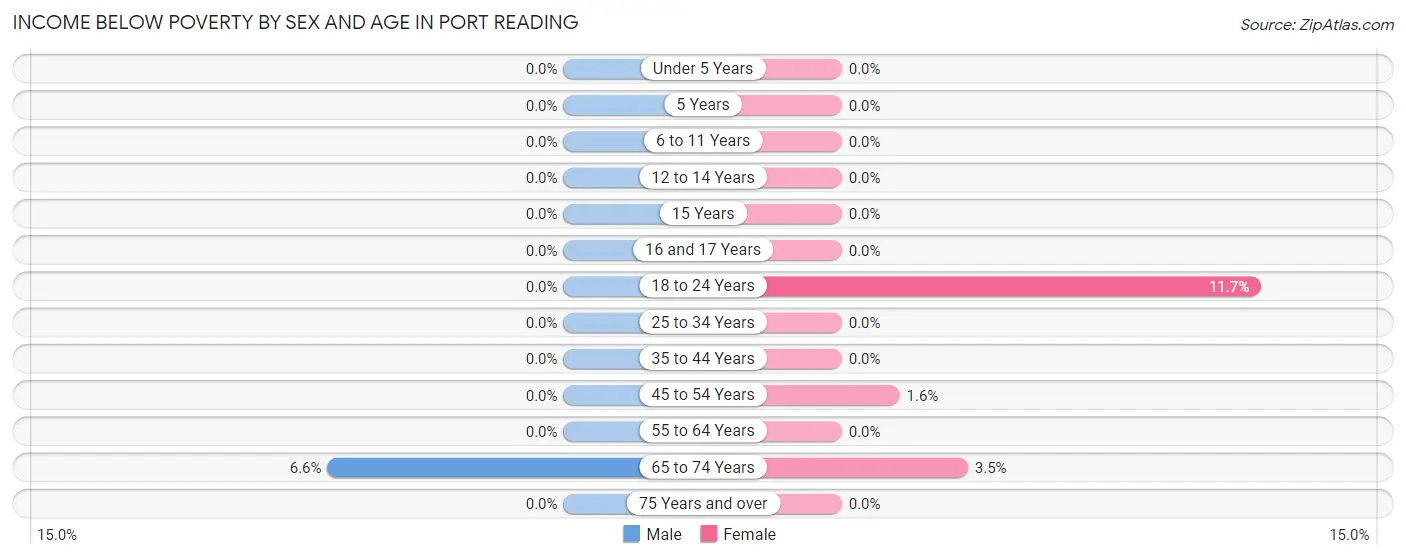
| Age Bracket | Male | Female |
| Under 5 Years | 0 (0.0%) | 0 (0.0%) |
| 5 Years | 0 (0.0%) | 0 (0.0%) |
| 6 to 11 Years | 0 (0.0%) | 0 (0.0%) |
| 12 to 14 Years | 0 (0.0%) | 0 (0.0%) |
| 15 Years | 0 (0.0%) | 0 (0.0%) |
| 16 and 17 Years | 0 (0.0%) | 0 (0.0%) |
| 18 to 24 Years | 0 (0.0%) | 14 (11.7%) |
| 25 to 34 Years | 0 (0.0%) | 0 (0.0%) |
| 35 to 44 Years | 0 (0.0%) | 0 (0.0%) |
| 45 to 54 Years | 0 (0.0%) | 5 (1.6%) |
| 55 to 64 Years | 0 (0.0%) | 0 (0.0%) |
| 65 to 74 Years | 9 (6.6%) | 8 (3.5%) |
| 75 Years and over | 0 (0.0%) | 0 (0.0%) |
| Total | 9 (0.4%) | 27 (1.4%) |
Income Above Poverty by Sex and Age in Port Reading
According to the poverty statistics in Port Reading, males aged under 5 years and females aged under 5 years are the age groups that are most secure financially, with 100.0% of males and 100.0% of females in these age groups living above the poverty line.
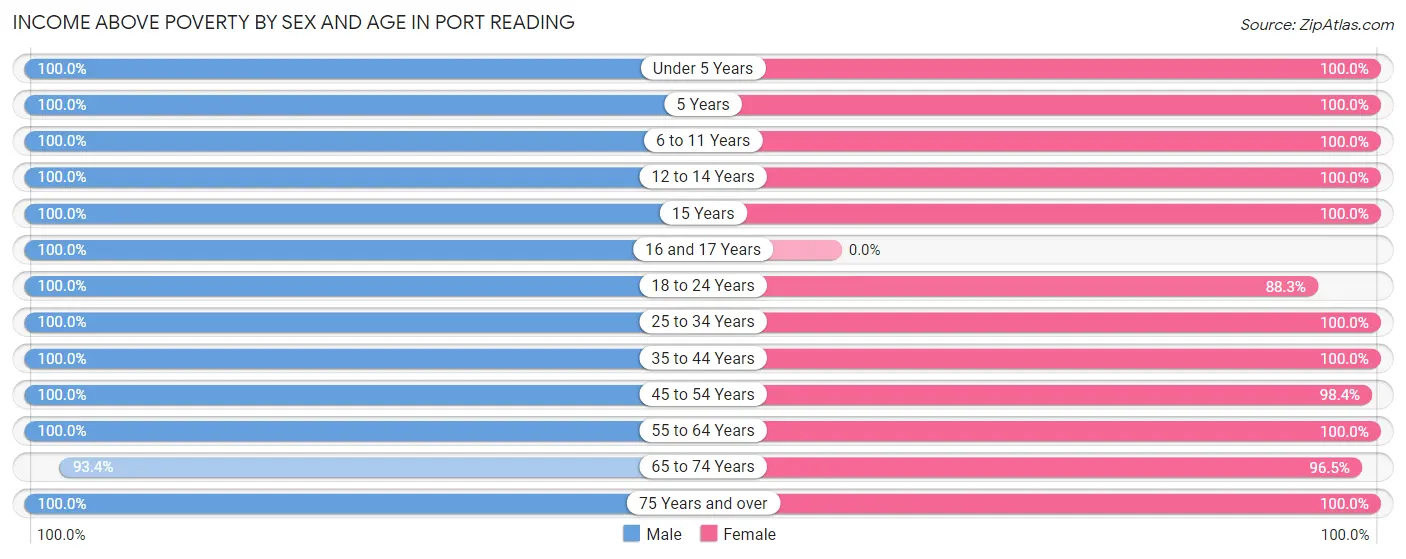
| Age Bracket | Male | Female |
| Under 5 Years | 101 (100.0%) | 109 (100.0%) |
| 5 Years | 31 (100.0%) | 6 (100.0%) |
| 6 to 11 Years | 205 (100.0%) | 134 (100.0%) |
| 12 to 14 Years | 107 (100.0%) | 89 (100.0%) |
| 15 Years | 33 (100.0%) | 21 (100.0%) |
| 16 and 17 Years | 109 (100.0%) | 0 (0.0%) |
| 18 to 24 Years | 170 (100.0%) | 106 (88.3%) |
| 25 to 34 Years | 334 (100.0%) | 204 (100.0%) |
| 35 to 44 Years | 150 (100.0%) | 317 (100.0%) |
| 45 to 54 Years | 465 (100.0%) | 306 (98.4%) |
| 55 to 64 Years | 210 (100.0%) | 247 (100.0%) |
| 65 to 74 Years | 128 (93.4%) | 220 (96.5%) |
| 75 Years and over | 57 (100.0%) | 145 (100.0%) |
| Total | 2,100 (99.6%) | 1,904 (98.6%) |
Income Below Poverty Among Married-Couple Families in Port Reading

| Children | Above Poverty | Below Poverty |
| No Children | 337 (100.0%) | 0 (0.0%) |
| 1 or 2 Children | 355 (100.0%) | 0 (0.0%) |
| 3 or 4 Children | 8 (100.0%) | 0 (0.0%) |
| 5 or more Children | 0 (0.0%) | 0 (0.0%) |
| Total | 700 (100.0%) | 0 (0.0%) |
Income Below Poverty Among Single-Parent Households in Port Reading

| Children | Single Father | Single Mother |
| No Children | 0 (0.0%) | 0 (0.0%) |
| 1 or 2 Children | 0 (0.0%) | 0 (0.0%) |
| 3 or 4 Children | 0 (0.0%) | 0 (0.0%) |
| 5 or more Children | 0 (0.0%) | 0 (0.0%) |
| Total | 0 (0.0%) | 0 (0.0%) |
Income Below Poverty Among Married-Couple vs Single-Parent Households in Port Reading

| Children | Married-Couple Families | Single-Parent Households |
| No Children | 0 (0.0%) | 0 (0.0%) |
| 1 or 2 Children | 0 (0.0%) | 0 (0.0%) |
| 3 or 4 Children | 0 (0.0%) | 0 (0.0%) |
| 5 or more Children | 0 (0.0%) | 0 (0.0%) |
| Total | 0 (0.0%) | 0 (0.0%) |
Race in Port Reading
The most populous races in Port Reading are Hispanic or Latino (1,963 | 48.6%), White / Caucasian (1,720 | 42.6%), and Some other Race (1,105 | 27.4%).

| Race | # Population | % Population |
| Asian | 472 | 11.7% |
| Black / African American | 429 | 10.6% |
| Hawaiian / Pacific | 0 | 0.0% |
| Hispanic or Latino | 1,963 | 48.6% |
| Native / Alaskan | 9 | 0.2% |
| White / Caucasian | 1,720 | 42.6% |
| Two or more Races | 305 | 7.5% |
| Some other Race | 1,105 | 27.4% |
| Total | 4,040 | 100.0% |
Ancestry in Port Reading
The most populous ancestries reported in Port Reading are Central American (582 | 14.4%), Honduran (523 | 13.0%), Puerto Rican (482 | 11.9%), Italian (449 | 11.1%), and South American (338 | 8.4%), together accounting for 58.8% of all Port Reading residents.
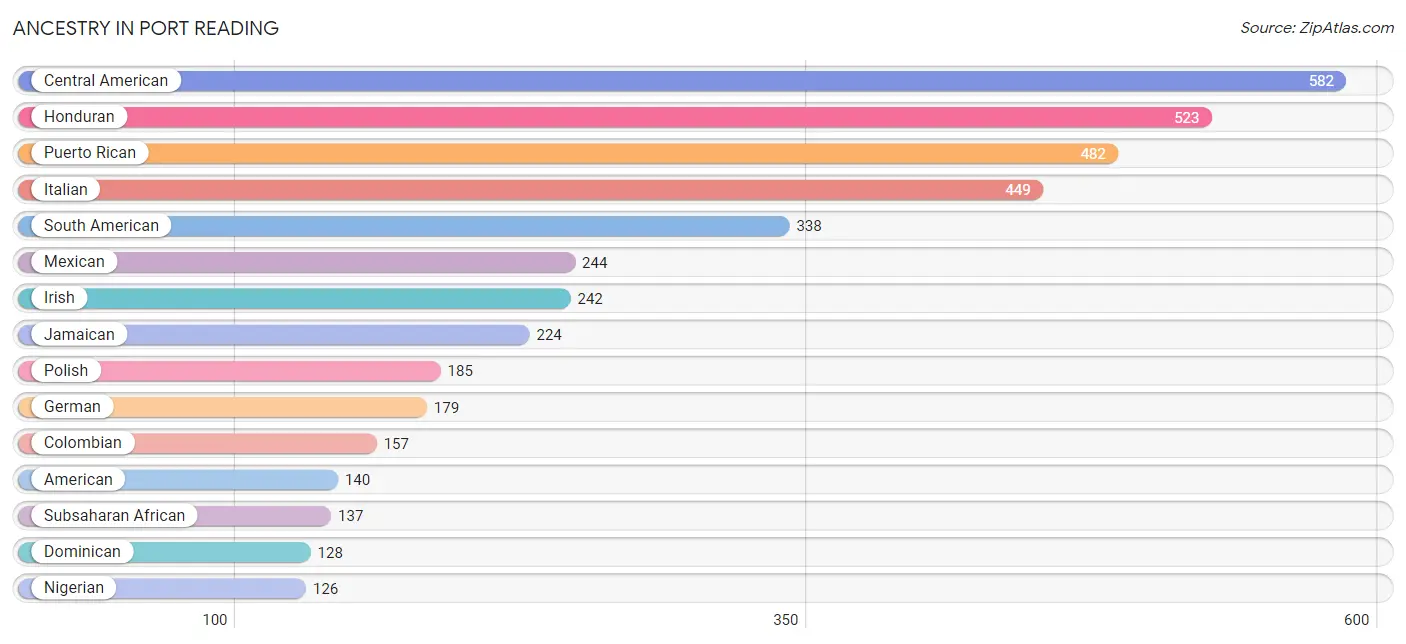
| Ancestry | # Population | % Population |
| African | 11 | 0.3% |
| American | 140 | 3.5% |
| Arab | 38 | 0.9% |
| Argentinean | 85 | 2.1% |
| Austrian | 8 | 0.2% |
| Bhutanese | 10 | 0.3% |
| Blackfeet | 28 | 0.7% |
| British West Indian | 38 | 0.9% |
| Burmese | 67 | 1.7% |
| Celtic | 16 | 0.4% |
| Central American | 582 | 14.4% |
| Chilean | 22 | 0.5% |
| Colombian | 157 | 3.9% |
| Croatian | 6 | 0.2% |
| Cuban | 114 | 2.8% |
| Czechoslovakian | 7 | 0.2% |
| Dominican | 128 | 3.2% |
| Dutch | 15 | 0.4% |
| Eastern European | 18 | 0.4% |
| Ecuadorian | 53 | 1.3% |
| English | 81 | 2.0% |
| French | 8 | 0.2% |
| French Canadian | 6 | 0.2% |
| German | 179 | 4.4% |
| Greek | 27 | 0.7% |
| Guyanese | 18 | 0.4% |
| Honduran | 523 | 13.0% |
| Hungarian | 118 | 2.9% |
| Indian (Asian) | 97 | 2.4% |
| Irish | 242 | 6.0% |
| Italian | 449 | 11.1% |
| Jamaican | 224 | 5.5% |
| Korean | 62 | 1.5% |
| Lebanese | 5 | 0.1% |
| Mexican | 244 | 6.0% |
| Nigerian | 126 | 3.1% |
| Peruvian | 21 | 0.5% |
| Polish | 185 | 4.6% |
| Portuguese | 57 | 1.4% |
| Puerto Rican | 482 | 11.9% |
| Salvadoran | 59 | 1.5% |
| Scotch-Irish | 13 | 0.3% |
| Scottish | 5 | 0.1% |
| Slavic | 7 | 0.2% |
| Slovak | 56 | 1.4% |
| South American | 338 | 8.4% |
| Spaniard | 75 | 1.9% |
| Subsaharan African | 137 | 3.4% |
| Swedish | 14 | 0.4% |
| Thai | 92 | 2.3% |
| Ukrainian | 65 | 1.6% |
| Welsh | 6 | 0.2% |
| West Indian | 35 | 0.9% | View All 53 Rows |
Immigrants in Port Reading
The most numerous immigrant groups reported in Port Reading came from Latin America (974 | 24.1%), Central America (635 | 15.7%), Honduras (415 | 10.3%), Asia (265 | 6.6%), and South America (194 | 4.8%), together accounting for 61.5% of all Port Reading residents.
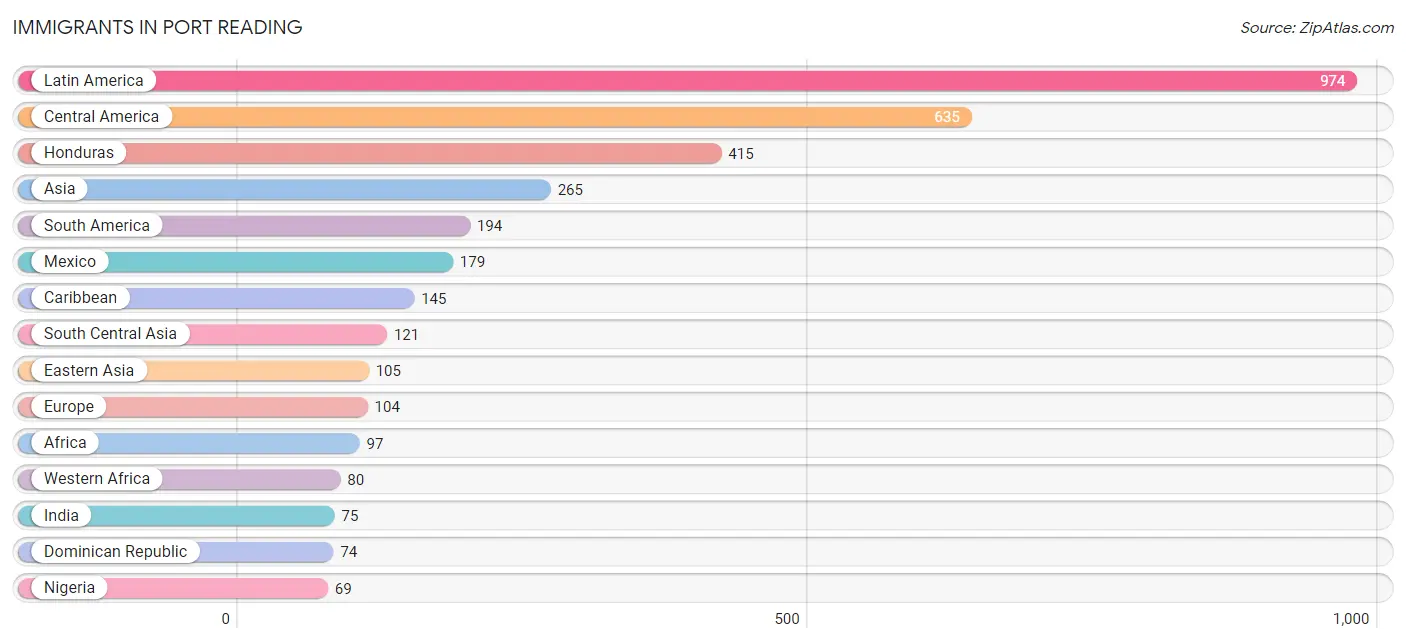
| Immigration Origin | # Population | % Population |
| Africa | 97 | 2.4% |
| Argentina | 34 | 0.8% |
| Asia | 265 | 6.6% |
| Caribbean | 145 | 3.6% |
| Central America | 635 | 15.7% |
| Chile | 22 | 0.5% |
| China | 60 | 1.5% |
| Colombia | 52 | 1.3% |
| Cuba | 12 | 0.3% |
| Czechoslovakia | 17 | 0.4% |
| Dominican Republic | 74 | 1.8% |
| Eastern Asia | 105 | 2.6% |
| Eastern Europe | 43 | 1.1% |
| Ecuador | 53 | 1.3% |
| El Salvador | 23 | 0.6% |
| Europe | 104 | 2.6% |
| Germany | 11 | 0.3% |
| Ghana | 11 | 0.3% |
| Greece | 11 | 0.3% |
| Guyana | 18 | 0.4% |
| Honduras | 415 | 10.3% |
| India | 75 | 1.9% |
| Italy | 10 | 0.3% |
| Jamaica | 59 | 1.5% |
| Korea | 45 | 1.1% |
| Latin America | 974 | 24.1% |
| Mexico | 179 | 4.4% |
| Nigeria | 69 | 1.7% |
| Northern Africa | 17 | 0.4% |
| Panama | 18 | 0.4% |
| Peru | 15 | 0.4% |
| Philippines | 32 | 0.8% |
| Poland | 25 | 0.6% |
| Portugal | 29 | 0.7% |
| South America | 194 | 4.8% |
| South Central Asia | 121 | 3.0% |
| South Eastern Asia | 39 | 1.0% |
| Southern Europe | 50 | 1.2% |
| Sri Lanka | 46 | 1.1% |
| Sudan | 17 | 0.4% |
| Ukraine | 1 | 0.0% |
| Vietnam | 7 | 0.2% |
| Western Africa | 80 | 2.0% |
| Western Europe | 11 | 0.3% | View All 44 Rows |
Sex and Age in Port Reading
Sex and Age in Port Reading
The most populous age groups in Port Reading are 45 to 49 Years (315 | 14.9%) for men and 40 to 44 Years (196 | 10.2%) for women.
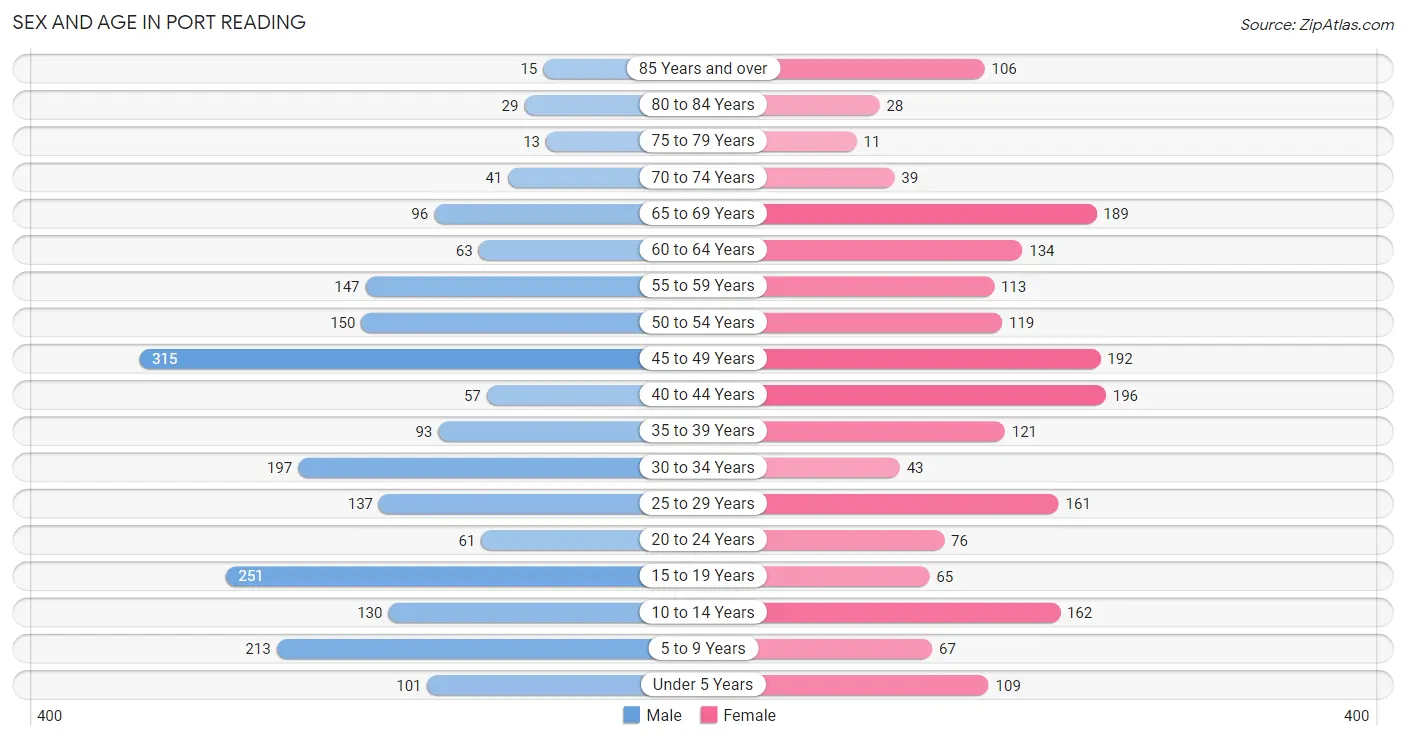
| Age Bracket | Male | Female |
| Under 5 Years | 101 (4.8%) | 109 (5.6%) |
| 5 to 9 Years | 213 (10.1%) | 67 (3.5%) |
| 10 to 14 Years | 130 (6.2%) | 162 (8.4%) |
| 15 to 19 Years | 251 (11.9%) | 65 (3.4%) |
| 20 to 24 Years | 61 (2.9%) | 76 (3.9%) |
| 25 to 29 Years | 137 (6.5%) | 161 (8.3%) |
| 30 to 34 Years | 197 (9.3%) | 43 (2.2%) |
| 35 to 39 Years | 93 (4.4%) | 121 (6.3%) |
| 40 to 44 Years | 57 (2.7%) | 196 (10.2%) |
| 45 to 49 Years | 315 (14.9%) | 192 (9.9%) |
| 50 to 54 Years | 150 (7.1%) | 119 (6.2%) |
| 55 to 59 Years | 147 (7.0%) | 113 (5.9%) |
| 60 to 64 Years | 63 (3.0%) | 134 (6.9%) |
| 65 to 69 Years | 96 (4.5%) | 189 (9.8%) |
| 70 to 74 Years | 41 (1.9%) | 39 (2.0%) |
| 75 to 79 Years | 13 (0.6%) | 11 (0.6%) |
| 80 to 84 Years | 29 (1.4%) | 28 (1.5%) |
| 85 Years and over | 15 (0.7%) | 106 (5.5%) |
| Total | 2,109 (100.0%) | 1,931 (100.0%) |
Families and Households in Port Reading
Median Family Size in Port Reading
The median family size in Port Reading is 3.72 persons per family, with single female/mother families (211 | 21.0%) accounting for the largest median family size of 5.27 persons per family. On the other hand, single male/father families (95 | 9.4%) represent the smallest median family size with 2.83 persons per family.

| Family Type | # Families | Family Size |
| Married-Couple | 700 (69.6%) | 3.38 |
| Single Male/Father | 95 (9.4%) | 2.83 |
| Single Female/Mother | 211 (21.0%) | 5.27 |
| Total Families | 1,006 (100.0%) | 3.72 |
Median Household Size in Port Reading
The median household size in Port Reading is 3.31 persons per household, with single female/mother households (211 | 17.3%) accounting for the largest median household size of 5.27 persons per household. non-family households (213 | 17.5%) represent the smallest median household size with 1.17 persons per household.

| Household Type | # Households | Household Size |
| Married-Couple | 700 (57.4%) | 3.43 |
| Single Male/Father | 95 (7.8%) | 2.91 |
| Single Female/Mother | 211 (17.3%) | 5.27 |
| Non-family | 213 (17.5%) | 1.17 |
| Total Households | 1,219 (100.0%) | 3.31 |
Household Size by Marriage Status in Port Reading
Out of a total of 1,219 households in Port Reading, 1,006 (82.5%) are family households, while 213 (17.5%) are nonfamily households. The most numerous type of family households are 3-person households, comprising 303, and the most common type of nonfamily households are 1-person households, comprising 180.

| Household Size | Family Households | Nonfamily Households |
| 1-Person Households | - | 180 (14.8%) |
| 2-Person Households | 272 (22.3%) | 33 (2.7%) |
| 3-Person Households | 303 (24.9%) | 0 (0.0%) |
| 4-Person Households | 237 (19.4%) | 0 (0.0%) |
| 5-Person Households | 116 (9.5%) | 0 (0.0%) |
| 6-Person Households | 30 (2.5%) | 0 (0.0%) |
| 7+ Person Households | 48 (3.9%) | 0 (0.0%) |
| Total | 1,006 (82.5%) | 213 (17.5%) |
Female Fertility in Port Reading
Fertility by Age in Port Reading
Average fertility rate in Port Reading is 139.0 births per 1,000 women. Women in the age bracket of 20 to 34 years have the highest fertility rate with 164.0 births per 1,000 women. Women in the age bracket of 35 to 50 years acount for 62.6% of all women with births.

| Age Bracket | Women with Births | Births / 1,000 Women |
| 15 to 19 years | 0 (0.0%) | 0.0 |
| 20 to 34 years | 46 (37.4%) | 164.0 |
| 35 to 50 years | 77 (62.6%) | 143.0 |
| Total | 123 (100.0%) | 139.0 |
Fertility by Age by Marriage Status in Port Reading
62.6% of women with births (123) in Port Reading are married. The highest percentage of unmarried women with births falls into 20 to 34 years age bracket with 100.0% of them unmarried at the time of birth, while the lowest percentage of unmarried women with births belong to 35 to 50 years age bracket with 0.0% of them unmarried.

| Age Bracket | Married | Unmarried |
| 15 to 19 years | 0 (0.0%) | 0 (0.0%) |
| 20 to 34 years | 0 (0.0%) | 46 (100.0%) |
| 35 to 50 years | 77 (100.0%) | 0 (0.0%) |
| Total | 77 (62.6%) | 46 (37.4%) |
Fertility by Education in Port Reading
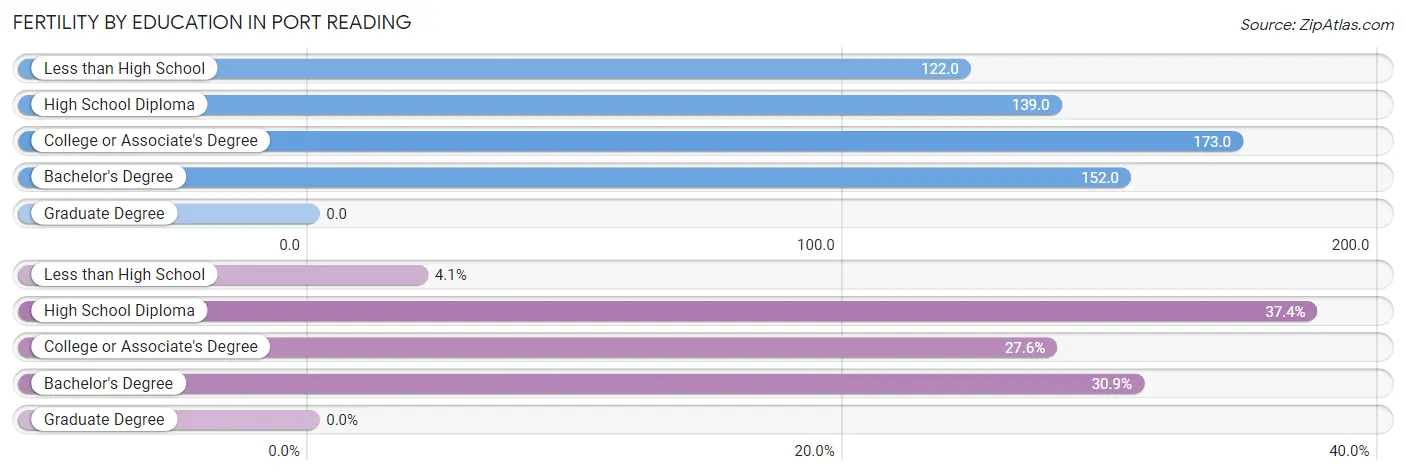
| Educational Attainment | Women with Births | Births / 1,000 Women |
| Less than High School | 5 (4.1%) | 122.0 |
| High School Diploma | 46 (37.4%) | 139.0 |
| College or Associate's Degree | 34 (27.6%) | 173.0 |
| Bachelor's Degree | 38 (30.9%) | 152.0 |
| Graduate Degree | 0 (0.0%) | 0.0 |
| Total | 123 (100.0%) | 139.0 |
Fertility by Education by Marriage Status in Port Reading
37.4% of women with births in Port Reading are unmarried. Women with the educational attainment of less than high school are most likely to be married with 100.0% of them married at childbirth, while women with the educational attainment of high school diploma are least likely to be married with 100.0% of them unmarried at childbirth.

| Educational Attainment | Married | Unmarried |
| Less than High School | 5 (100.0%) | 0 (0.0%) |
| High School Diploma | 0 (0.0%) | 46 (100.0%) |
| College or Associate's Degree | 34 (100.0%) | 0 (0.0%) |
| Bachelor's Degree | 38 (100.0%) | 0 (0.0%) |
| Graduate Degree | 0 (0.0%) | 0 (0.0%) |
| Total | 77 (62.6%) | 46 (37.4%) |
Employment Characteristics in Port Reading
Employment by Class of Employer in Port Reading
Among the 2,189 employed individuals in Port Reading, private company employees (1,566 | 71.5%), local government employees (232 | 10.6%), and self-employed (incorporated) (144 | 6.6%) make up the most common classes of employment.

| Employer Class | # Employees | % Employees |
| Private Company Employees | 1,566 | 71.5% |
| Self-Employed (Incorporated) | 144 | 6.6% |
| Self-Employed (Not Incorporated) | 66 | 3.0% |
| Not-for-profit Organizations | 86 | 3.9% |
| Local Government Employees | 232 | 10.6% |
| State Government Employees | 44 | 2.0% |
| Federal Government Employees | 24 | 1.1% |
| Unpaid Family Workers | 27 | 1.2% |
| Total | 2,189 | 100.0% |
Employment Status by Age in Port Reading
According to the labor force statistics for Port Reading, out of the total population over 16 years of age (3,204), 74.2% or 2,377 individuals are in the labor force, with 5.5% or 131 of them unemployed. The age group with the highest labor force participation rate is 25 to 29 years, with 98.3% or 293 individuals in the labor force. Within the labor force, the 16 to 19 years age range has the highest percentage of unemployed individuals, with 57.9% or 55 of them being unemployed.

| Age Bracket | In Labor Force | Unemployed |
| 16 to 19 Years | 95 (36.3%) | 55 (57.9%) |
| 20 to 24 Years | 99 (72.3%) | 13 (12.8%) |
| 25 to 29 Years | 293 (98.3%) | 0 (0.0%) |
| 30 to 34 Years | 231 (96.3%) | 0 (0.0%) |
| 35 to 44 Years | 375 (80.3%) | 57 (15.2%) |
| 45 to 54 Years | 746 (96.1%) | 0 (0.0%) |
| 55 to 59 Years | 217 (83.5%) | 0 (0.0%) |
| 60 to 64 Years | 145 (73.6%) | 7 (4.8%) |
| 65 to 74 Years | 169 (46.3%) | 0 (0.0%) |
| 75 Years and over | 7 (3.5%) | 0 (0.0%) |
| Total | 2,377 (74.2%) | 131 (5.5%) |
Employment Status by Educational Attainment in Port Reading
According to labor force statistics for Port Reading, 89.7% of individuals (2,007) out of the total population between 25 and 64 years of age (2,238) are in the labor force, with 3.2% or 64 of them being unemployed. The group with the highest labor force participation rate are those with the educational attainment of bachelor's degree or higher, with 93.2% or 725 individuals in the labor force. Within the labor force, individuals with high school diploma education have the highest percentage of unemployment, with 8.2% or 49 of them being unemployed.

| Educational Attainment | In Labor Force | Unemployed |
| Less than High School | 114 (78.6%) | 10 (7.0%) |
| High School Diploma | 601 (87.7%) | 56 (8.2%) |
| College / Associate Degree | 567 (90.0%) | 0 (0.0%) |
| Bachelor's Degree or higher | 725 (93.2%) | 8 (1.0%) |
| Total | 2,007 (89.7%) | 72 (3.2%) |
Employment Occupations by Sex in Port Reading
Management, Business, Science and Arts Occupations
The most common Management, Business, Science and Arts occupations in Port Reading are Management (277 | 12.4%), Community & Social Service (258 | 11.5%), Education Instruction & Library (114 | 5.1%), Arts, Media & Entertainment (101 | 4.5%), and Business & Financial (99 | 4.4%).
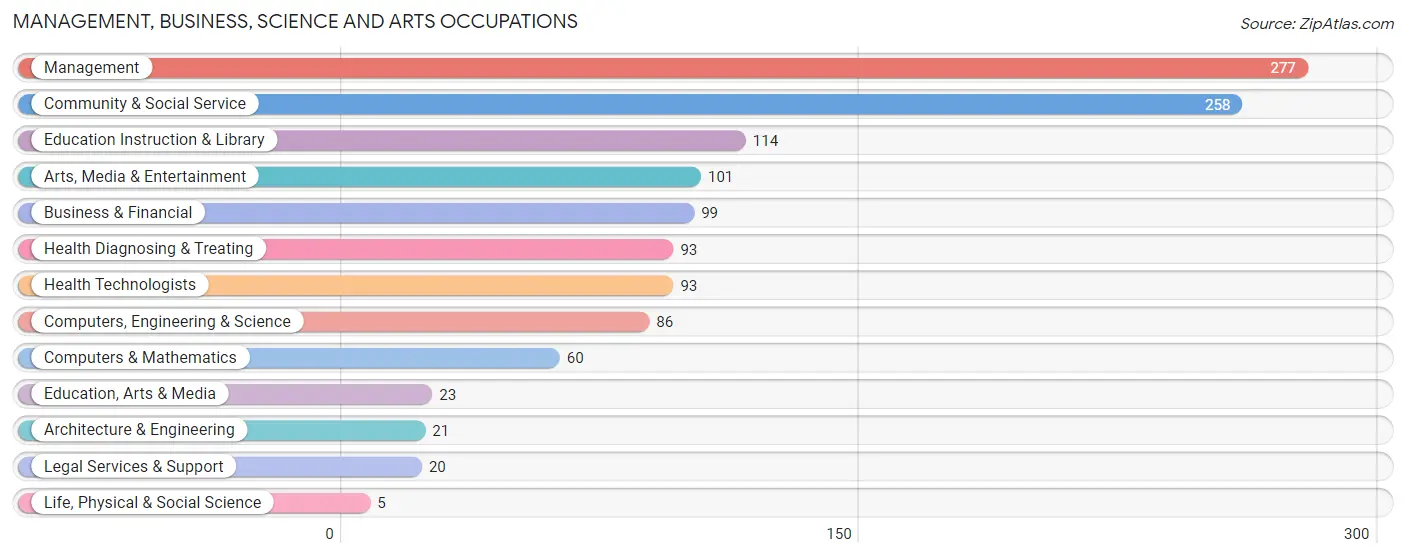
Management, Business, Science and Arts Occupations by Sex
Within the Management, Business, Science and Arts occupations in Port Reading, the most male-oriented occupations are Architecture & Engineering (100.0%), Computers, Engineering & Science (79.1%), and Management (78.7%), while the most female-oriented occupations are Life, Physical & Social Science (100.0%), Education, Arts & Media (91.3%), and Education Instruction & Library (75.4%).
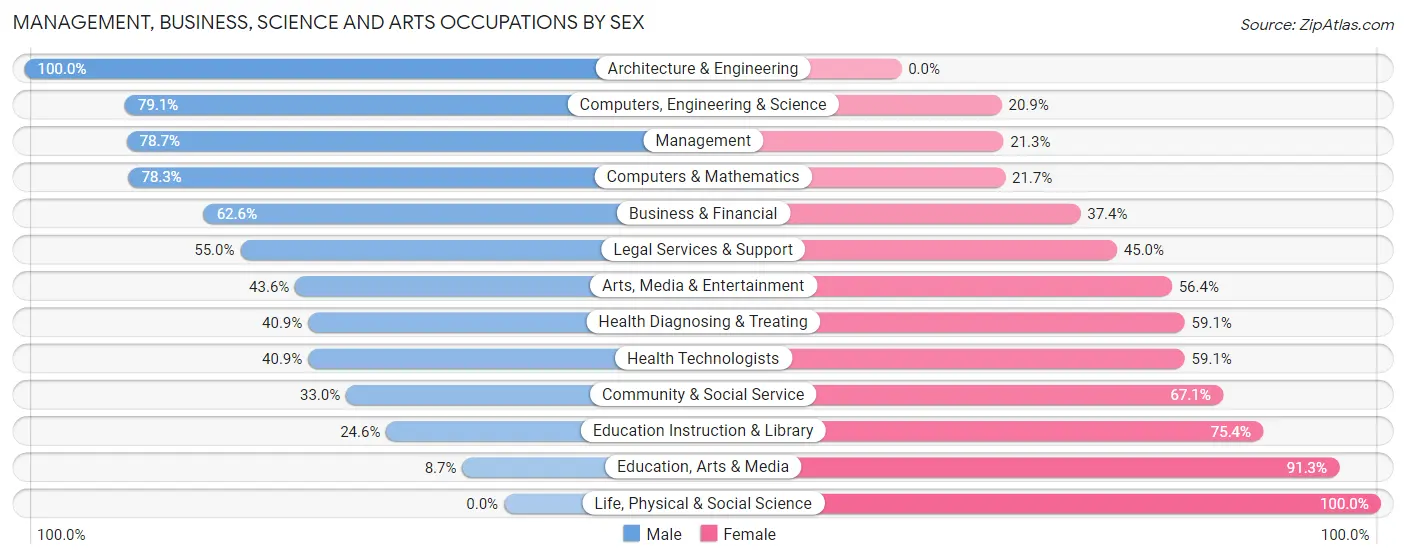
| Occupation | Male | Female |
| Management | 218 (78.7%) | 59 (21.3%) |
| Business & Financial | 62 (62.6%) | 37 (37.4%) |
| Computers, Engineering & Science | 68 (79.1%) | 18 (20.9%) |
| Computers & Mathematics | 47 (78.3%) | 13 (21.7%) |
| Architecture & Engineering | 21 (100.0%) | 0 (0.0%) |
| Life, Physical & Social Science | 0 (0.0%) | 5 (100.0%) |
| Community & Social Service | 85 (33.0%) | 173 (67.0%) |
| Education, Arts & Media | 2 (8.7%) | 21 (91.3%) |
| Legal Services & Support | 11 (55.0%) | 9 (45.0%) |
| Education Instruction & Library | 28 (24.6%) | 86 (75.4%) |
| Arts, Media & Entertainment | 44 (43.6%) | 57 (56.4%) |
| Health Diagnosing & Treating | 38 (40.9%) | 55 (59.1%) |
| Health Technologists | 38 (40.9%) | 55 (59.1%) |
| Total (Category) | 471 (57.9%) | 342 (42.1%) |
| Total (Overall) | 1,228 (54.8%) | 1,013 (45.2%) |
Services Occupations
The most common Services occupations in Port Reading are Security & Protection (127 | 5.7%), Cleaning & Maintenance (89 | 4.0%), Firefighting & Prevention (82 | 3.7%), Food Preparation & Serving (79 | 3.5%), and Healthcare Support (48 | 2.1%).

Services Occupations by Sex
Within the Services occupations in Port Reading, the most male-oriented occupations are Firefighting & Prevention (100.0%), Security & Protection (92.1%), and Cleaning & Maintenance (92.1%), while the most female-oriented occupations are Healthcare Support (100.0%), Personal Care & Service (100.0%), and Food Preparation & Serving (73.4%).

| Occupation | Male | Female |
| Healthcare Support | 0 (0.0%) | 48 (100.0%) |
| Security & Protection | 117 (92.1%) | 10 (7.9%) |
| Firefighting & Prevention | 82 (100.0%) | 0 (0.0%) |
| Law Enforcement | 35 (77.8%) | 10 (22.2%) |
| Food Preparation & Serving | 21 (26.6%) | 58 (73.4%) |
| Cleaning & Maintenance | 82 (92.1%) | 7 (7.9%) |
| Personal Care & Service | 0 (0.0%) | 31 (100.0%) |
| Total (Category) | 220 (58.8%) | 154 (41.2%) |
| Total (Overall) | 1,228 (54.8%) | 1,013 (45.2%) |
Sales and Office Occupations
The most common Sales and Office occupations in Port Reading are Office & Administration (356 | 15.9%), and Sales & Related (229 | 10.2%).

Sales and Office Occupations by Sex

| Occupation | Male | Female |
| Sales & Related | 167 (72.9%) | 62 (27.1%) |
| Office & Administration | 50 (14.0%) | 306 (86.0%) |
| Total (Category) | 217 (37.1%) | 368 (62.9%) |
| Total (Overall) | 1,228 (54.8%) | 1,013 (45.2%) |
Natural Resources, Construction and Maintenance Occupations
The most common Natural Resources, Construction and Maintenance occupations in Port Reading are Construction & Extraction (40 | 1.8%), and Installation, Maintenance & Repair (38 | 1.7%).

Natural Resources, Construction and Maintenance Occupations by Sex

| Occupation | Male | Female |
| Farming, Fishing & Forestry | 0 (0.0%) | 0 (0.0%) |
| Construction & Extraction | 40 (100.0%) | 0 (0.0%) |
| Installation, Maintenance & Repair | 24 (63.2%) | 14 (36.8%) |
| Total (Category) | 64 (82.1%) | 14 (17.9%) |
| Total (Overall) | 1,228 (54.8%) | 1,013 (45.2%) |
Production, Transportation and Moving Occupations
The most common Production, Transportation and Moving occupations in Port Reading are Transportation (235 | 10.5%), Material Moving (103 | 4.6%), and Production (53 | 2.4%).

Production, Transportation and Moving Occupations by Sex

| Occupation | Male | Female |
| Production | 27 (50.9%) | 26 (49.1%) |
| Transportation | 185 (78.7%) | 50 (21.3%) |
| Material Moving | 44 (42.7%) | 59 (57.3%) |
| Total (Category) | 256 (65.5%) | 135 (34.5%) |
| Total (Overall) | 1,228 (54.8%) | 1,013 (45.2%) |
Employment Industries by Sex in Port Reading
Employment Industries in Port Reading
The major employment industries in Port Reading include Retail Trade (427 | 19.1%), Transportation & Warehousing (226 | 10.1%), Health Care & Social Assistance (225 | 10.0%), Manufacturing (208 | 9.3%), and Educational Services (183 | 8.2%).
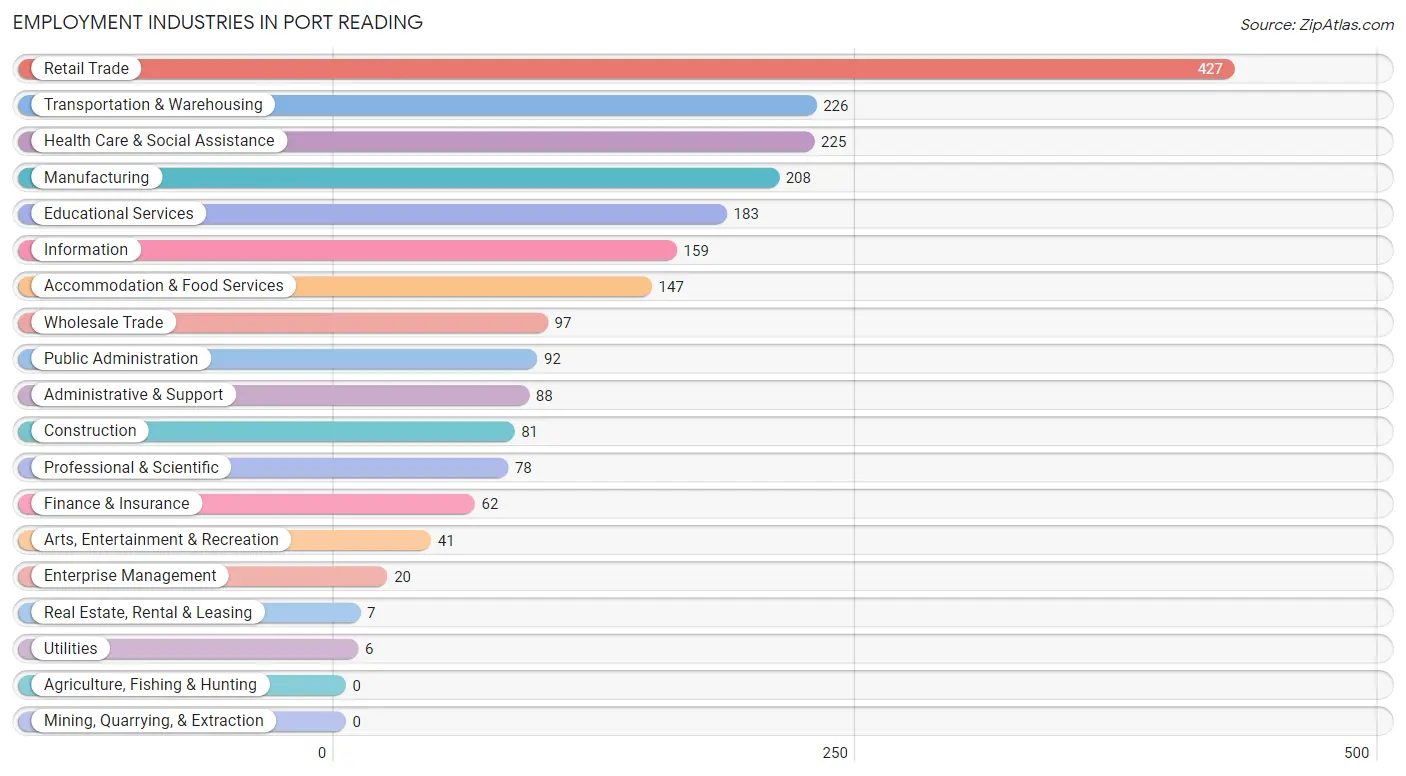
Employment Industries by Sex in Port Reading
The Port Reading industries that see more men than women are Wholesale Trade (100.0%), Enterprise Management (100.0%), and Construction (93.8%), whereas the industries that tend to have a higher number of women are Utilities (100.0%), Real Estate, Rental & Leasing (100.0%), and Arts, Entertainment & Recreation (100.0%).
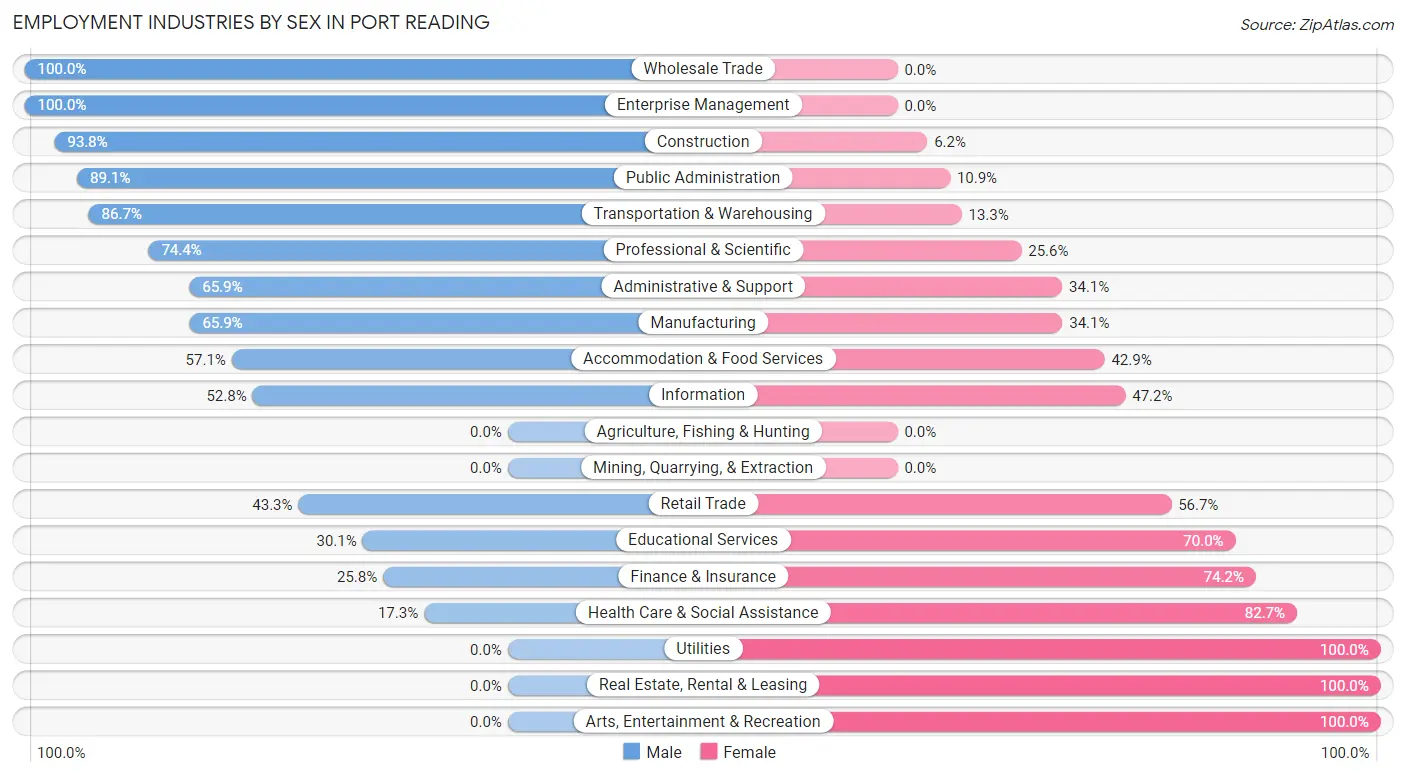
| Industry | Male | Female |
| Agriculture, Fishing & Hunting | 0 (0.0%) | 0 (0.0%) |
| Mining, Quarrying, & Extraction | 0 (0.0%) | 0 (0.0%) |
| Construction | 76 (93.8%) | 5 (6.2%) |
| Manufacturing | 137 (65.9%) | 71 (34.1%) |
| Wholesale Trade | 97 (100.0%) | 0 (0.0%) |
| Retail Trade | 185 (43.3%) | 242 (56.7%) |
| Transportation & Warehousing | 196 (86.7%) | 30 (13.3%) |
| Utilities | 0 (0.0%) | 6 (100.0%) |
| Information | 84 (52.8%) | 75 (47.2%) |
| Finance & Insurance | 16 (25.8%) | 46 (74.2%) |
| Real Estate, Rental & Leasing | 0 (0.0%) | 7 (100.0%) |
| Professional & Scientific | 58 (74.4%) | 20 (25.6%) |
| Enterprise Management | 20 (100.0%) | 0 (0.0%) |
| Administrative & Support | 58 (65.9%) | 30 (34.1%) |
| Educational Services | 55 (30.0%) | 128 (70.0%) |
| Health Care & Social Assistance | 39 (17.3%) | 186 (82.7%) |
| Arts, Entertainment & Recreation | 0 (0.0%) | 41 (100.0%) |
| Accommodation & Food Services | 84 (57.1%) | 63 (42.9%) |
| Public Administration | 82 (89.1%) | 10 (10.9%) |
| Total | 1,228 (54.8%) | 1,013 (45.2%) |
Education in Port Reading
School Enrollment in Port Reading
The most common levels of schooling among the 925 students in Port Reading are middle school (339 | 36.6%), high school (190 | 20.5%), and elementary school (170 | 18.4%).

| School Level | # Students | % Students |
| Nursery / Preschool | 18 | 1.9% |
| Kindergarten | 51 | 5.5% |
| Elementary School | 170 | 18.4% |
| Middle School | 339 | 36.6% |
| High School | 190 | 20.5% |
| College / Undergraduate | 133 | 14.4% |
| Graduate / Professional | 24 | 2.6% |
| Total | 925 | 100.0% |
School Enrollment by Age by Funding Source in Port Reading
Out of a total of 925 students who are enrolled in schools in Port Reading, 43 (4.6%) attend a private institution, while the remaining 882 (95.4%) are enrolled in public schools. The age group of 3 to 4 year olds has the highest likelihood of being enrolled in private schools, with 7 (58.3% in the age bracket) enrolled. Conversely, the age group of 5 to 9 year old has the lowest likelihood of being enrolled in a private school, with 280 (100.0% in the age bracket) attending a public institution.

| Age Bracket | Public School | Private School |
| 3 to 4 Year Olds | 5 (41.7%) | 7 (58.3%) |
| 5 to 9 Year Old | 280 (100.0%) | 0 (0.0%) |
| 10 to 14 Year Olds | 286 (100.0%) | 0 (0.0%) |
| 15 to 17 Year Olds | 163 (100.0%) | 0 (0.0%) |
| 18 to 19 Year Olds | 65 (100.0%) | 0 (0.0%) |
| 20 to 24 Year Olds | 43 (64.2%) | 24 (35.8%) |
| 25 to 34 Year Olds | 15 (55.6%) | 12 (44.4%) |
| 35 Years and over | 25 (100.0%) | 0 (0.0%) |
| Total | 882 (95.4%) | 43 (4.6%) |
Educational Attainment by Field of Study in Port Reading
Psychology (140 | 14.7%), science & technology (137 | 14.4%), business (104 | 10.9%), education (98 | 10.3%), and engineering (95 | 10.0%) are the most common fields of study among 953 individuals in Port Reading who have obtained a bachelor's degree or higher.
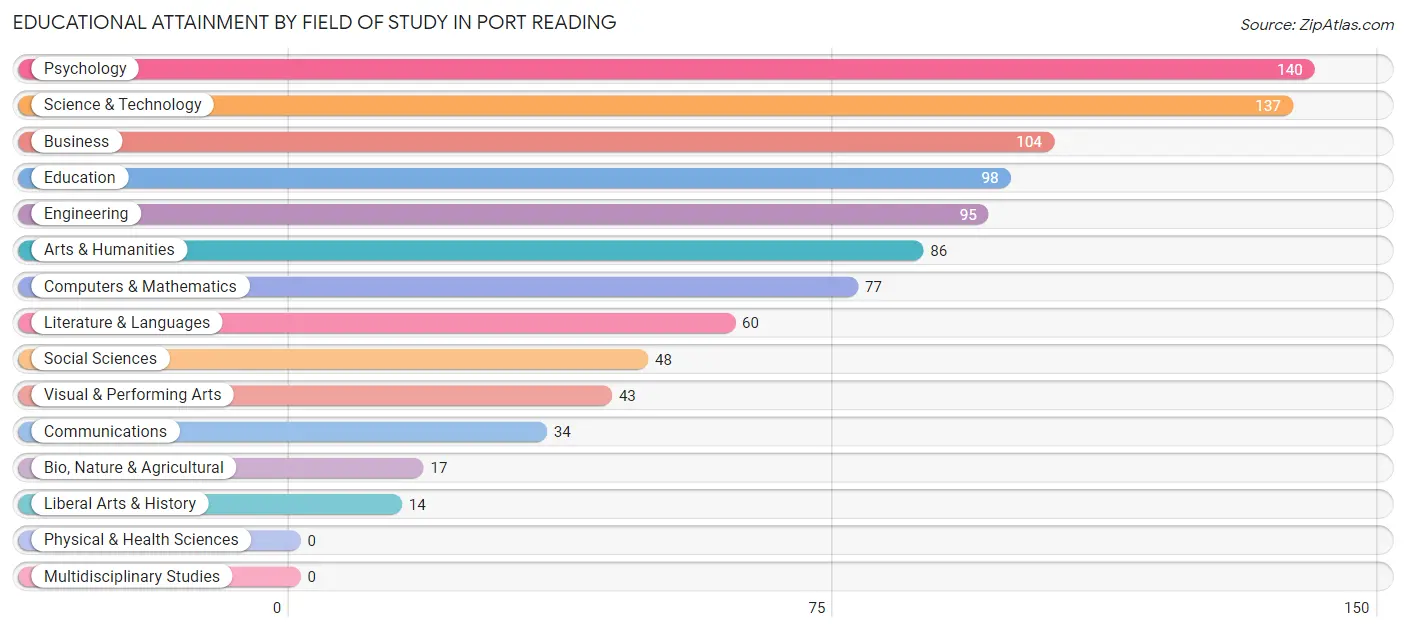
| Field of Study | # Graduates | % Graduates |
| Computers & Mathematics | 77 | 8.1% |
| Bio, Nature & Agricultural | 17 | 1.8% |
| Physical & Health Sciences | 0 | 0.0% |
| Psychology | 140 | 14.7% |
| Social Sciences | 48 | 5.0% |
| Engineering | 95 | 10.0% |
| Multidisciplinary Studies | 0 | 0.0% |
| Science & Technology | 137 | 14.4% |
| Business | 104 | 10.9% |
| Education | 98 | 10.3% |
| Literature & Languages | 60 | 6.3% |
| Liberal Arts & History | 14 | 1.5% |
| Visual & Performing Arts | 43 | 4.5% |
| Communications | 34 | 3.6% |
| Arts & Humanities | 86 | 9.0% |
| Total | 953 | 100.0% |
Transportation & Commute in Port Reading
Vehicle Availability by Sex in Port Reading
The most prevalent vehicle ownership categories in Port Reading are males with 2 vehicles (404, accounting for 32.8%) and females with 2 vehicles (336, making up 42.3%).

| Vehicles Available | Male | Female |
| No Vehicle | 35 (2.8%) | 0 (0.0%) |
| 1 Vehicle | 311 (25.3%) | 201 (21.0%) |
| 2 Vehicles | 404 (32.8%) | 336 (35.1%) |
| 3 Vehicles | 216 (17.5%) | 215 (22.5%) |
| 4 Vehicles | 240 (19.5%) | 176 (18.4%) |
| 5 or more Vehicles | 25 (2.0%) | 28 (2.9%) |
| Total | 1,231 (100.0%) | 956 (100.0%) |
Commute Time in Port Reading
The most frequently occuring commute durations in Port Reading are 30 to 34 minutes (321 commuters, 15.5%), 20 to 24 minutes (302 commuters, 14.6%), and 45 to 59 minutes (247 commuters, 11.9%).
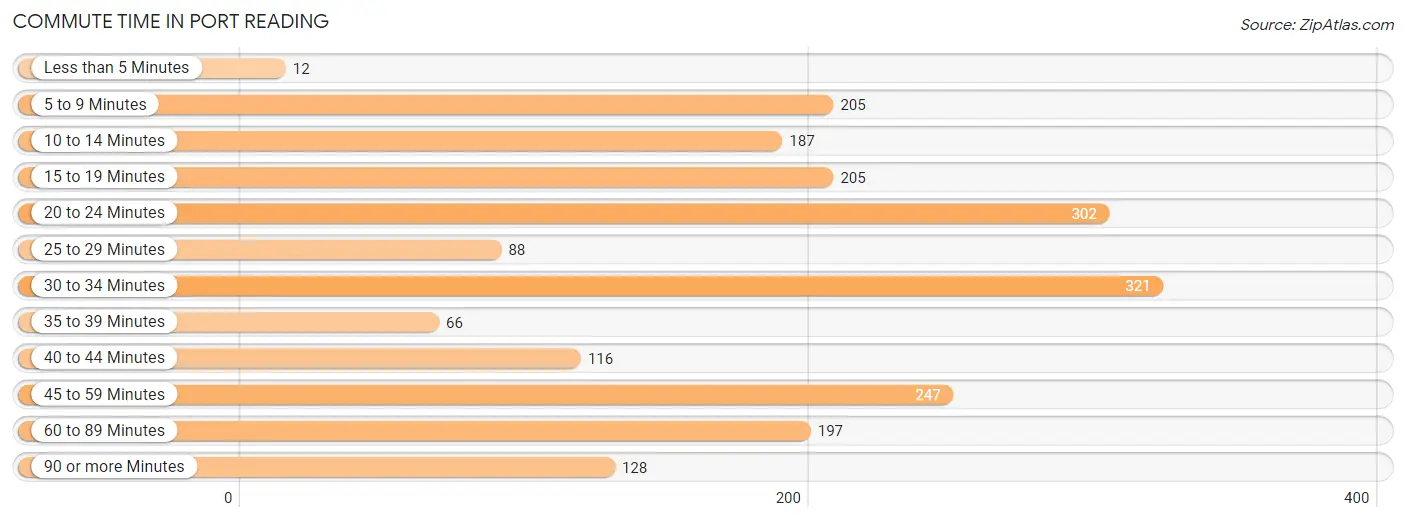
| Commute Time | # Commuters | % Commuters |
| Less than 5 Minutes | 12 | 0.6% |
| 5 to 9 Minutes | 205 | 9.9% |
| 10 to 14 Minutes | 187 | 9.0% |
| 15 to 19 Minutes | 205 | 9.9% |
| 20 to 24 Minutes | 302 | 14.6% |
| 25 to 29 Minutes | 88 | 4.2% |
| 30 to 34 Minutes | 321 | 15.5% |
| 35 to 39 Minutes | 66 | 3.2% |
| 40 to 44 Minutes | 116 | 5.6% |
| 45 to 59 Minutes | 247 | 11.9% |
| 60 to 89 Minutes | 197 | 9.5% |
| 90 or more Minutes | 128 | 6.2% |
Commute Time by Sex in Port Reading
The most common commute times in Port Reading are 20 to 24 minutes (225 commuters, 18.7%) for males and 30 to 34 minutes (171 commuters, 19.7%) for females.
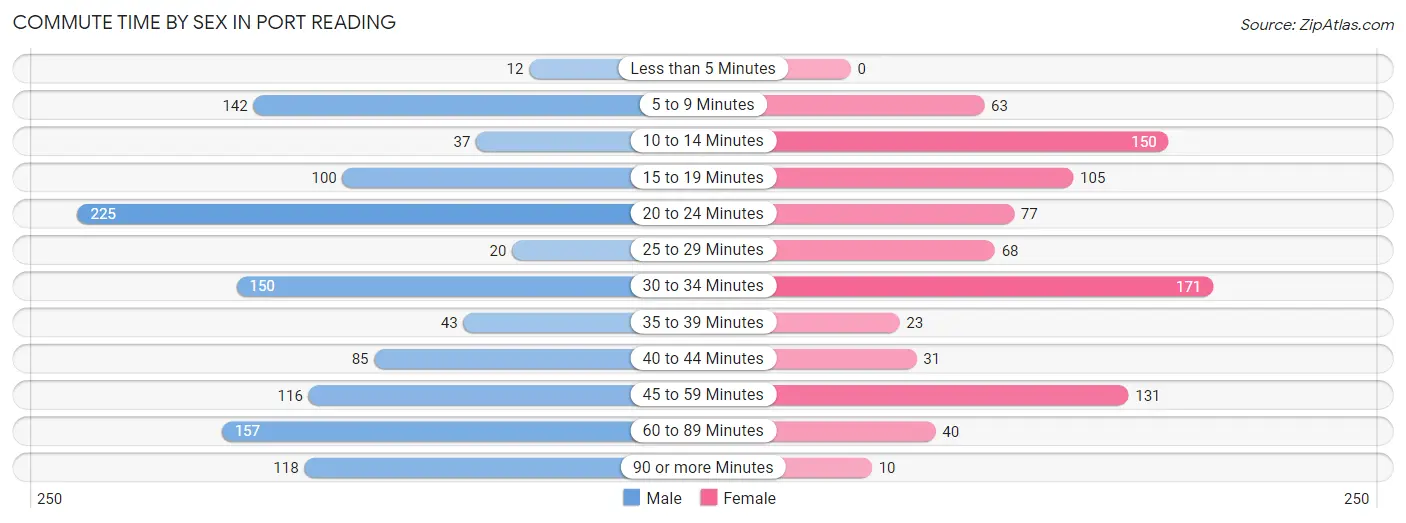
| Commute Time | Male | Female |
| Less than 5 Minutes | 12 (1.0%) | 0 (0.0%) |
| 5 to 9 Minutes | 142 (11.8%) | 63 (7.2%) |
| 10 to 14 Minutes | 37 (3.1%) | 150 (17.3%) |
| 15 to 19 Minutes | 100 (8.3%) | 105 (12.1%) |
| 20 to 24 Minutes | 225 (18.7%) | 77 (8.9%) |
| 25 to 29 Minutes | 20 (1.7%) | 68 (7.8%) |
| 30 to 34 Minutes | 150 (12.4%) | 171 (19.7%) |
| 35 to 39 Minutes | 43 (3.6%) | 23 (2.6%) |
| 40 to 44 Minutes | 85 (7.0%) | 31 (3.6%) |
| 45 to 59 Minutes | 116 (9.6%) | 131 (15.1%) |
| 60 to 89 Minutes | 157 (13.0%) | 40 (4.6%) |
| 90 or more Minutes | 118 (9.8%) | 10 (1.1%) |
Time of Departure to Work by Sex in Port Reading
The most frequent times of departure to work in Port Reading are 7:00 AM to 7:29 AM (326, 27.1%) for males and 7:00 AM to 7:29 AM (125, 14.4%) for females.
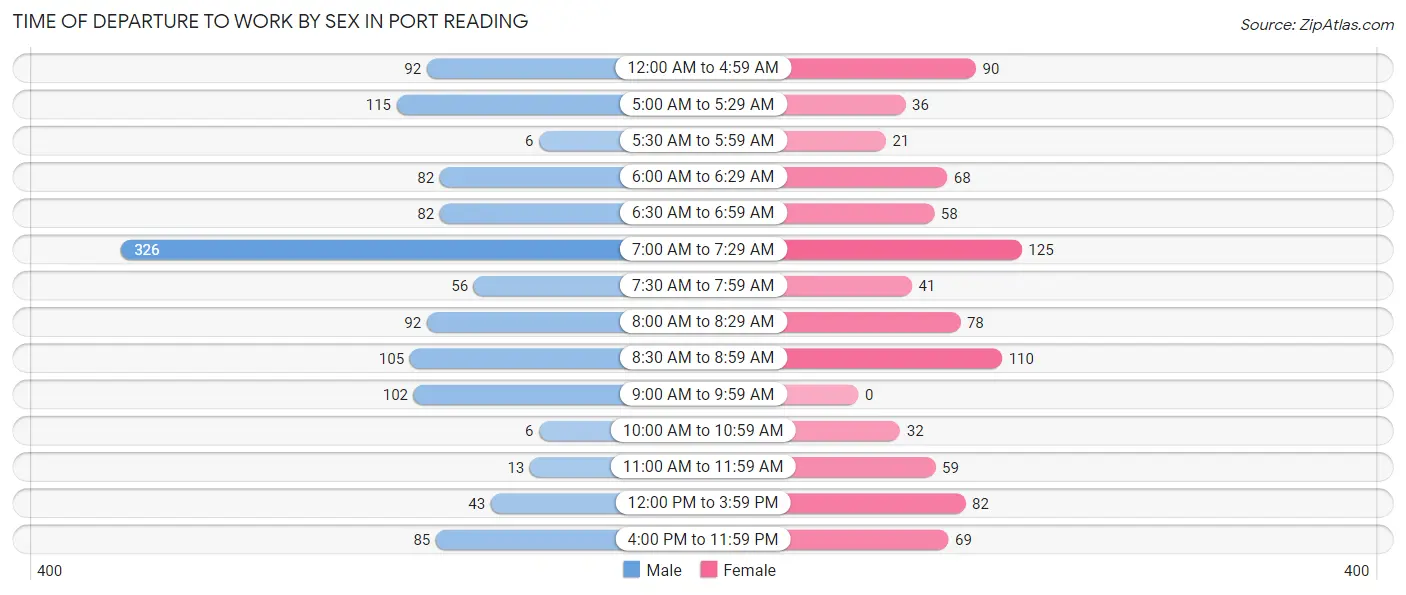
| Time of Departure | Male | Female |
| 12:00 AM to 4:59 AM | 92 (7.6%) | 90 (10.4%) |
| 5:00 AM to 5:29 AM | 115 (9.5%) | 36 (4.1%) |
| 5:30 AM to 5:59 AM | 6 (0.5%) | 21 (2.4%) |
| 6:00 AM to 6:29 AM | 82 (6.8%) | 68 (7.8%) |
| 6:30 AM to 6:59 AM | 82 (6.8%) | 58 (6.7%) |
| 7:00 AM to 7:29 AM | 326 (27.1%) | 125 (14.4%) |
| 7:30 AM to 7:59 AM | 56 (4.6%) | 41 (4.7%) |
| 8:00 AM to 8:29 AM | 92 (7.6%) | 78 (9.0%) |
| 8:30 AM to 8:59 AM | 105 (8.7%) | 110 (12.7%) |
| 9:00 AM to 9:59 AM | 102 (8.5%) | 0 (0.0%) |
| 10:00 AM to 10:59 AM | 6 (0.5%) | 32 (3.7%) |
| 11:00 AM to 11:59 AM | 13 (1.1%) | 59 (6.8%) |
| 12:00 PM to 3:59 PM | 43 (3.6%) | 82 (9.4%) |
| 4:00 PM to 11:59 PM | 85 (7.0%) | 69 (7.9%) |
| Total | 1,205 (100.0%) | 869 (100.0%) |
Housing Occupancy in Port Reading
Occupancy by Ownership in Port Reading
Of the total 1,219 dwellings in Port Reading, owner-occupied units account for 1,131 (92.8%), while renter-occupied units make up 88 (7.2%).

| Occupancy | # Housing Units | % Housing Units |
| Owner Occupied Housing Units | 1,131 | 92.8% |
| Renter-Occupied Housing Units | 88 | 7.2% |
| Total Occupied Housing Units | 1,219 | 100.0% |
Occupancy by Household Size in Port Reading

| Household Size | # Housing Units | % Housing Units |
| 1-Person Household | 180 | 14.8% |
| 2-Person Household | 305 | 25.0% |
| 3-Person Household | 303 | 24.9% |
| 4+ Person Household | 431 | 35.4% |
| Total Housing Units | 1,219 | 100.0% |
Occupancy by Ownership by Household Size in Port Reading

| Household Size | Owner-occupied | Renter-occupied |
| 1-Person Household | 122 (67.8%) | 58 (32.2%) |
| 2-Person Household | 305 (100.0%) | 0 (0.0%) |
| 3-Person Household | 303 (100.0%) | 0 (0.0%) |
| 4+ Person Household | 401 (93.0%) | 30 (7.0%) |
| Total Housing Units | 1,131 (92.8%) | 88 (7.2%) |
Occupancy by Educational Attainment in Port Reading

| Household Size | Owner-occupied | Renter-occupied |
| Less than High School | 106 (95.5%) | 5 (4.5%) |
| High School Diploma | 325 (93.7%) | 22 (6.3%) |
| College/Associate Degree | 286 (82.4%) | 61 (17.6%) |
| Bachelor's Degree or higher | 414 (100.0%) | 0 (0.0%) |
Occupancy by Age of Householder in Port Reading

| Age Bracket | # Households | % Households |
| Under 35 Years | 168 | 13.8% |
| 35 to 44 Years | 67 | 5.5% |
| 45 to 54 Years | 365 | 29.9% |
| 55 to 64 Years | 264 | 21.7% |
| 65 to 74 Years | 237 | 19.4% |
| 75 to 84 Years | 48 | 3.9% |
| 85 Years and Over | 70 | 5.7% |
| Total | 1,219 | 100.0% |
Housing Finances in Port Reading
Median Income by Occupancy in Port Reading

| Occupancy Type | # Households | Median Income |
| Owner-Occupied | 1,131 (92.8%) | $142,161 |
| Renter-Occupied | 88 (7.2%) | $59,000 |
| Average | 1,219 (100.0%) | $139,864 |
Occupancy by Householder Income Bracket in Port Reading
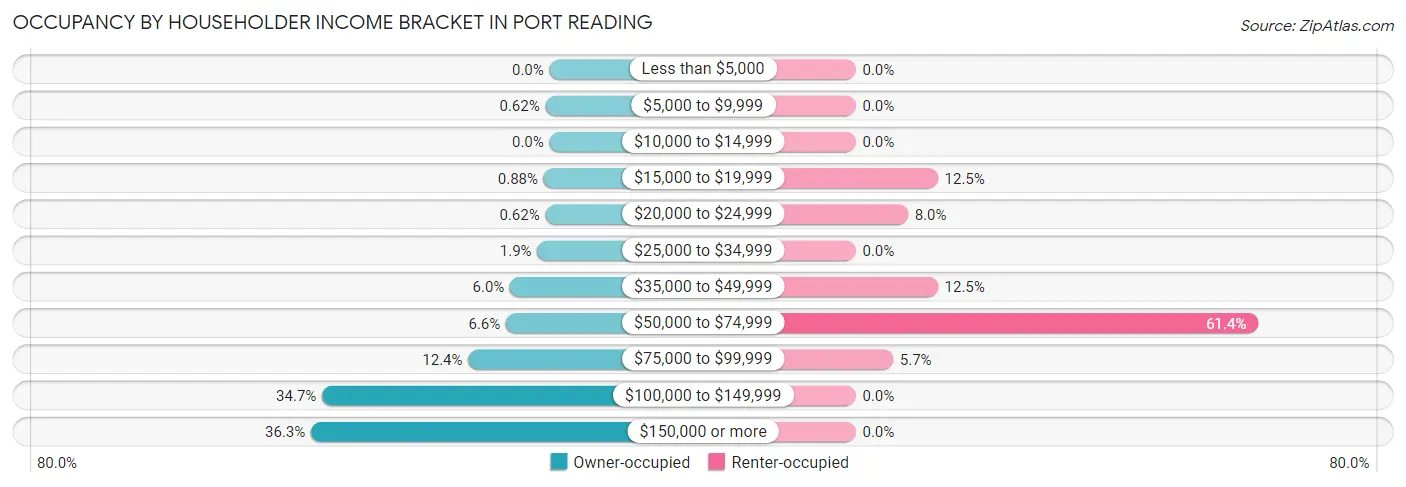
| Income Bracket | Owner-occupied | Renter-occupied |
| Less than $5,000 | 0 (0.0%) | 0 (0.0%) |
| $5,000 to $9,999 | 7 (0.6%) | 0 (0.0%) |
| $10,000 to $14,999 | 0 (0.0%) | 0 (0.0%) |
| $15,000 to $19,999 | 10 (0.9%) | 11 (12.5%) |
| $20,000 to $24,999 | 7 (0.6%) | 7 (8.0%) |
| $25,000 to $34,999 | 21 (1.9%) | 0 (0.0%) |
| $35,000 to $49,999 | 68 (6.0%) | 11 (12.5%) |
| $50,000 to $74,999 | 75 (6.6%) | 54 (61.4%) |
| $75,000 to $99,999 | 140 (12.4%) | 5 (5.7%) |
| $100,000 to $149,999 | 392 (34.7%) | 0 (0.0%) |
| $150,000 or more | 411 (36.3%) | 0 (0.0%) |
| Total | 1,131 (100.0%) | 88 (100.0%) |
Monthly Housing Cost Tiers in Port Reading

| Monthly Cost | Owner-occupied | Renter-occupied |
| Less than $300 | 0 (0.0%) | 0 (0.0%) |
| $300 to $499 | 0 (0.0%) | 0 (0.0%) |
| $500 to $799 | 13 (1.1%) | 0 (0.0%) |
| $800 to $999 | 29 (2.6%) | 0 (0.0%) |
| $1,000 to $1,499 | 261 (23.1%) | 47 (53.4%) |
| $1,500 to $1,999 | 237 (20.9%) | 0 (0.0%) |
| $2,000 to $2,499 | 175 (15.5%) | 30 (34.1%) |
| $2,500 to $2,999 | 172 (15.2%) | 0 (0.0%) |
| $3,000 or more | 244 (21.6%) | 0 (0.0%) |
| Total | 1,131 (100.0%) | 88 (100.0%) |
Physical Housing Characteristics in Port Reading
Housing Structures in Port Reading

| Structure Type | # Housing Units | % Housing Units |
| Single Unit, Detached | 1,109 | 91.0% |
| Single Unit, Attached | 19 | 1.6% |
| 2 Unit Apartments | 91 | 7.5% |
| 3 or 4 Unit Apartments | 0 | 0.0% |
| 5 to 9 Unit Apartments | 0 | 0.0% |
| 10 or more Apartments | 0 | 0.0% |
| Mobile Home / Other | 0 | 0.0% |
| Total | 1,219 | 100.0% |
Housing Structures by Occupancy in Port Reading

| Structure Type | Owner-occupied | Renter-occupied |
| Single Unit, Detached | 1,044 (94.1%) | 65 (5.9%) |
| Single Unit, Attached | 19 (100.0%) | 0 (0.0%) |
| 2 Unit Apartments | 68 (74.7%) | 23 (25.3%) |
| 3 or 4 Unit Apartments | 0 (0.0%) | 0 (0.0%) |
| 5 to 9 Unit Apartments | 0 (0.0%) | 0 (0.0%) |
| 10 or more Apartments | 0 (0.0%) | 0 (0.0%) |
| Mobile Home / Other | 0 (0.0%) | 0 (0.0%) |
| Total | 1,131 (92.8%) | 88 (7.2%) |
Housing Structures by Number of Rooms in Port Reading

| Number of Rooms | Owner-occupied | Renter-occupied |
| 1 Room | 0 (0.0%) | 0 (0.0%) |
| 2 or 3 Rooms | 7 (0.6%) | 29 (33.0%) |
| 4 or 5 Rooms | 215 (19.0%) | 23 (26.1%) |
| 6 or 7 Rooms | 569 (50.3%) | 25 (28.4%) |
| 8 or more Rooms | 340 (30.1%) | 11 (12.5%) |
| Total | 1,131 (100.0%) | 88 (100.0%) |
Housing Structure by Heating Type in Port Reading

| Heating Type | Owner-occupied | Renter-occupied |
| Utility Gas | 1,004 (88.8%) | 88 (100.0%) |
| Bottled, Tank, or LP Gas | 7 (0.6%) | 0 (0.0%) |
| Electricity | 71 (6.3%) | 0 (0.0%) |
| Fuel Oil or Kerosene | 49 (4.3%) | 0 (0.0%) |
| Coal or Coke | 0 (0.0%) | 0 (0.0%) |
| All other Fuels | 0 (0.0%) | 0 (0.0%) |
| No Fuel Used | 0 (0.0%) | 0 (0.0%) |
| Total | 1,131 (100.0%) | 88 (100.0%) |
Household Vehicle Usage in Port Reading

| Vehicles per Household | Owner-occupied | Renter-occupied |
| No Vehicle | 41 (3.6%) | 0 (0.0%) |
| 1 Vehicle | 275 (24.3%) | 58 (65.9%) |
| 2 Vehicles | 443 (39.2%) | 30 (34.1%) |
| 3 or more Vehicles | 372 (32.9%) | 0 (0.0%) |
| Total | 1,131 (100.0%) | 88 (100.0%) |
Real Estate & Mortgages in Port Reading
Real Estate and Mortgage Overview in Port Reading
| Characteristic | Without Mortgage | With Mortgage |
| Housing Units | 374 | 757 |
| Median Property Value | $406,800 | $390,600 |
| Median Household Income | $101,471 | $308 |
| Monthly Housing Costs | $1,384 | $244 |
| Real Estate Taxes | $10,001 | $0 |
Property Value by Mortgage Status in Port Reading

| Property Value | Without Mortgage | With Mortgage |
| Less than $50,000 | 0 (0.0%) | 13 (1.7%) |
| $50,000 to $99,999 | 13 (3.5%) | 10 (1.3%) |
| $100,000 to $299,999 | 25 (6.7%) | 178 (23.5%) |
| $300,000 to $499,999 | 299 (79.9%) | 479 (63.3%) |
| $500,000 to $749,999 | 7 (1.9%) | 62 (8.2%) |
| $750,000 to $999,999 | 23 (6.1%) | 0 (0.0%) |
| $1,000,000 or more | 7 (1.9%) | 15 (2.0%) |
| Total | 374 (100.0%) | 757 (100.0%) |
Household Income by Mortgage Status in Port Reading

| Household Income | Without Mortgage | With Mortgage |
| Less than $10,000 | 7 (1.9%) | 26 (3.4%) |
| $10,000 to $24,999 | 17 (4.5%) | 0 (0.0%) |
| $25,000 to $34,999 | 21 (5.6%) | 0 (0.0%) |
| $35,000 to $49,999 | 32 (8.6%) | 0 (0.0%) |
| $50,000 to $74,999 | 61 (16.3%) | 36 (4.8%) |
| $75,000 to $99,999 | 39 (10.4%) | 14 (1.8%) |
| $100,000 to $149,999 | 94 (25.1%) | 101 (13.3%) |
| $150,000 or more | 103 (27.5%) | 298 (39.4%) |
| Total | 374 (100.0%) | 757 (100.0%) |
Property Value to Household Income Ratio in Port Reading

| Value-to-Income Ratio | Without Mortgage | With Mortgage |
| Less than 2.0x | 30 (8.0%) | 145,423 (19,210.4%) |
| 2.0x to 2.9x | 100 (26.7%) | 250 (33.0%) |
| 3.0x to 3.9x | 83 (22.2%) | 215 (28.4%) |
| 4.0x or more | 161 (43.0%) | 182 (24.0%) |
| Total | 374 (100.0%) | 757 (100.0%) |
Real Estate Taxes by Mortgage Status in Port Reading

| Property Taxes | Without Mortgage | With Mortgage |
| Less than $800 | 0 (0.0%) | 0 (0.0%) |
| $800 to $1,499 | 0 (0.0%) | 0 (0.0%) |
| $800 to $1,499 | 368 (98.4%) | 0 (0.0%) |
| Total | 374 (100.0%) | 757 (100.0%) |
Health & Disability in Port Reading
Health Insurance Coverage by Age in Port Reading

| Age Bracket | With Coverage | Without Coverage |
| Under 6 Years | 247 (100.0%) | 0 (0.0%) |
| 6 to 18 Years | 736 (98.8%) | 9 (1.2%) |
| 19 to 25 Years | 298 (99.0%) | 3 (1.0%) |
| 26 to 34 Years | 388 (81.7%) | 87 (18.3%) |
| 35 to 44 Years | 452 (96.8%) | 15 (3.2%) |
| 45 to 54 Years | 722 (93.0%) | 54 (7.0%) |
| 55 to 64 Years | 457 (100.0%) | 0 (0.0%) |
| 65 to 74 Years | 365 (100.0%) | 0 (0.0%) |
| 75 Years and older | 202 (100.0%) | 0 (0.0%) |
| Total | 3,867 (95.8%) | 168 (4.2%) |
Health Insurance Coverage by Citizenship Status in Port Reading

| Citizenship Status | With Coverage | Without Coverage |
| Native Born | 247 (100.0%) | 0 (0.0%) |
| Foreign Born, Citizen | 736 (98.8%) | 9 (1.2%) |
| Foreign Born, not a Citizen | 298 (99.0%) | 3 (1.0%) |
Health Insurance Coverage by Household Income in Port Reading

| Household Income | With Coverage | Without Coverage |
| Under $25,000 | 42 (100.0%) | 0 (0.0%) |
| $25,000 to $49,999 | 217 (90.4%) | 23 (9.6%) |
| $50,000 to $74,999 | 331 (100.0%) | 0 (0.0%) |
| $75,000 to $99,999 | 275 (96.2%) | 11 (3.8%) |
| $100,000 and over | 2,999 (95.7%) | 134 (4.3%) |
Public vs Private Health Insurance Coverage by Age in Port Reading

| Age Bracket | Public Insurance | Private Insurance |
| Under 6 | 156 (63.2%) | 91 (36.8%) |
| 6 to 18 Years | 418 (56.1%) | 418 (56.1%) |
| 19 to 25 Years | 158 (52.5%) | 152 (50.5%) |
| 25 to 34 Years | 64 (13.5%) | 349 (73.5%) |
| 35 to 44 Years | 58 (12.4%) | 401 (85.9%) |
| 45 to 54 Years | 44 (5.7%) | 684 (88.1%) |
| 55 to 64 Years | 57 (12.5%) | 424 (92.8%) |
| 65 to 74 Years | 345 (94.5%) | 139 (38.1%) |
| 75 Years and over | 202 (100.0%) | 146 (72.3%) |
| Total | 1,502 (37.2%) | 2,804 (69.5%) |
Disability Status by Sex by Age in Port Reading

| Age Bracket | Male | Female |
| Under 5 Years | 0 (0.0%) | 0 (0.0%) |
| 5 to 17 Years | 27 (5.6%) | 0 (0.0%) |
| 18 to 34 Years | 27 (5.4%) | 46 (14.2%) |
| 35 to 64 Years | 19 (2.3%) | 29 (3.3%) |
| 65 to 74 Years | 15 (11.0%) | 61 (26.8%) |
| 75 Years and over | 15 (26.3%) | 56 (38.6%) |
Disability Class by Sex by Age in Port Reading
Disability Class: Hearing Difficulty

| Age Bracket | Male | Female |
| Under 5 Years | 0 (0.0%) | 0 (0.0%) |
| 5 to 17 Years | 0 (0.0%) | 0 (0.0%) |
| 18 to 34 Years | 0 (0.0%) | 0 (0.0%) |
| 35 to 64 Years | 0 (0.0%) | 0 (0.0%) |
| 65 to 74 Years | 0 (0.0%) | 16 (7.0%) |
| 75 Years and over | 15 (26.3%) | 27 (18.6%) |
Disability Class: Vision Difficulty

| Age Bracket | Male | Female |
| Under 5 Years | 0 (0.0%) | 0 (0.0%) |
| 5 to 17 Years | 0 (0.0%) | 0 (0.0%) |
| 18 to 34 Years | 0 (0.0%) | 34 (10.5%) |
| 35 to 64 Years | 7 (0.9%) | 6 (0.7%) |
| 65 to 74 Years | 0 (0.0%) | 20 (8.8%) |
| 75 Years and over | 0 (0.0%) | 10 (6.9%) |
Disability Class: Cognitive Difficulty

| Age Bracket | Male | Female |
| 5 to 17 Years | 12 (2.5%) | 0 (0.0%) |
| 18 to 34 Years | 27 (5.4%) | 21 (6.5%) |
| 35 to 64 Years | 0 (0.0%) | 18 (2.1%) |
| 65 to 74 Years | 0 (0.0%) | 22 (9.7%) |
| 75 Years and over | 7 (12.3%) | 29 (20.0%) |
Disability Class: Ambulatory Difficulty

| Age Bracket | Male | Female |
| 5 to 17 Years | 0 (0.0%) | 0 (0.0%) |
| 18 to 34 Years | 0 (0.0%) | 9 (2.8%) |
| 35 to 64 Years | 12 (1.5%) | 5 (0.6%) |
| 65 to 74 Years | 15 (11.0%) | 33 (14.5%) |
| 75 Years and over | 7 (12.3%) | 56 (38.6%) |
Disability Class: Self-Care Difficulty

| Age Bracket | Male | Female |
| 5 to 17 Years | 0 (0.0%) | 0 (0.0%) |
| 18 to 34 Years | 15 (3.0%) | 9 (2.8%) |
| 35 to 64 Years | 12 (1.5%) | 0 (0.0%) |
| 65 to 74 Years | 9 (6.6%) | 8 (3.5%) |
| 75 Years and over | 7 (12.3%) | 17 (11.7%) |
Technology Access in Port Reading
Computing Device Access in Port Reading

| Device Type | # Households | % Households |
| Desktop or Laptop | 1,109 | 91.0% |
| Smartphone | 1,111 | 91.1% |
| Tablet | 1,012 | 83.0% |
| No Computing Device | 64 | 5.2% |
| Total | 1,219 | 100.0% |
Internet Access in Port Reading

| Internet Type | # Households | % Households |
| Dial-Up Internet | 0 | 0.0% |
| Broadband Home | 999 | 82.0% |
| Cellular Data Only | 130 | 10.7% |
| Satellite Internet | 121 | 9.9% |
| No Internet | 82 | 6.7% |
| Total | 1,219 | 100.0% |
Port Reading Summary
Introduction
Port Reading is a small unincorporated community located in Woodbridge Township, Middlesex County, New Jersey. It is situated on the Arthur Kill, a tidal strait that separates Staten Island, New York from New Jersey. The community is home to a diverse population of approximately 1,500 people and is known for its industrial and maritime history.
History
Port Reading was first settled in the early 19th century by Dutch and English settlers. The area was originally known as “Port Reading Landing” and was used as a port for shipping and receiving goods. In 1871, the Central Railroad of New Jersey built a rail line through the area, connecting it to the rest of the state. This allowed for the development of the area as an industrial center, with factories and warehouses being built along the waterfront.
In the early 20th century, the area experienced a period of rapid growth and development. The Port Reading Refinery was built in 1915, and the Port Reading Chemical Works was established in 1917. The area also became home to a number of other industries, including a steel mill, a shipyard, and a coal yard.
Geography
Port Reading is located in Woodbridge Township, Middlesex County, New Jersey. It is situated on the Arthur Kill, a tidal strait that separates Staten Island, New York from New Jersey. The community is bordered by the Rahway River to the north, the Arthur Kill to the east, and the Raritan Bay to the south.
The area is mostly flat, with an elevation of approximately 10 feet above sea level. The climate is humid subtropical, with hot, humid summers and cold, wet winters.
Economy
Port Reading’s economy is largely based on its industrial and maritime history. The Port Reading Refinery is the largest employer in the area, providing jobs for over 1,000 people. Other major employers include the Port Reading Chemical Works, the Port Reading Steel Mill, and the Port Reading Shipyard.
The area is also home to a number of small businesses, including restaurants, retail stores, and service providers.
Demographics
As of the 2010 census, the population of Port Reading was 1,500. The racial makeup of the community was 79.2% White, 11.3% African American, 0.7% Native American, 2.3% Asian, and 6.5% from other races. The median household income was $50,000, and the median age was 38.
Conclusion
Port Reading is a small unincorporated community located in Woodbridge Township, Middlesex County, New Jersey. It is situated on the Arthur Kill, a tidal strait that separates Staten Island, New York from New Jersey. The community is home to a diverse population of approximately 1,500 people and is known for its industrial and maritime history. The area’s economy is largely based on its industrial and maritime history, with the Port Reading Refinery being the largest employer in the area. The population of Port Reading is mostly White, with a median household income of $50,000 and a median age of 38.
Common Questions
What is Per Capita Income in Port Reading?
Per Capita income in Port Reading is $42,821.
What is the Median Family Income in Port Reading?
Median Family Income in Port Reading is $143,977.
What is the Median Household income in Port Reading?
Median Household Income in Port Reading is $139,864.
What is Income or Wage Gap in Port Reading?
Income or Wage Gap in Port Reading is 12.2%.
Women in Port Reading earn 87.8 cents for every dollar earned by a man.
What is Inequality or Gini Index in Port Reading?
Inequality or Gini Index in Port Reading is 0.28.
What is the Total Population of Port Reading?
Total Population of Port Reading is 4,040.
What is the Total Male Population of Port Reading?
Total Male Population of Port Reading is 2,109.
What is the Total Female Population of Port Reading?
Total Female Population of Port Reading is 1,931.
What is the Ratio of Males per 100 Females in Port Reading?
There are 109.22 Males per 100 Females in Port Reading.
What is the Ratio of Females per 100 Males in Port Reading?
There are 91.56 Females per 100 Males in Port Reading.
What is the Median Population Age in Port Reading?
Median Population Age in Port Reading is 40.6 Years.
What is the Average Family Size in Port Reading
Average Family Size in Port Reading is 3.7 People.
What is the Average Household Size in Port Reading
Average Household Size in Port Reading is 3.3 People.
How Large is the Labor Force in Port Reading?
There are 2,377 People in the Labor Forcein in Port Reading.
What is the Percentage of People in the Labor Force in Port Reading?
74.2% of People are in the Labor Force in Port Reading.
What is the Unemployment Rate in Port Reading?
Unemployment Rate in Port Reading is 5.5%.